



"WE ARE A CLOSE NEIGHBOUR AND FAMILY BUT OUR FRIENDSHIP IS SPECIAL. BECAUSE NOT JUST TO THE TEST OF TIME BUT OVER THE DECADES IT HAS BEEN GOING FROM STRENGTH TO STRENGTH. WHAT DRIVES OUR FRIENDSHIP IS OUR LEADERSHIP."
— TSHERING TOBGAY, PRIME MINISTER, BHUTAN
SHARP CONTENT FOR A SHARP AUDIENCE SP’s ` 100.00 (INDIA-BASED BUYER ONLY) AN SP GUIDE PUBLICATION aviation www.sps-aviation.com
FALCONS
MILITARY FUTURE OF UNMANNED MILITARY AIRCRAFT ENGINES 50 MILLION FLIGHT HOURS OF LEAP EXCLUSIVE
&
RULE
VOL 27 ISSUE 6 • 2024 SPACE TOURISM JOURNEY TO THE BEYOND MUCH MORE... PAGE 15 EBACE '24 WITNESSED THE FALCON FAMILY, INCLUDING 6X, 8X, 2000LXS AND 10X, BEING SHOWCASED RNI NUMBER: DELENG/2008/24199
GLOBAL JET CAPITAL
FROM CROSS BORDER AND JURISDICTIONAL COMPLEXITIES TO IMPOSSIBLE TIMELINES, WE’VE BEEN THERE AND DONE THAT.
Our mission is simple: to transform a potentially complicated and timeconsuming transaction into a seamless, customized financing solution that meets your unique needs. Our decades of experience provide an unmatched level of expertise—and the ability to craft solutions for virtually any challenge—with speed and confidence. And our global footprint gives you access to on-the-ground expertise wherever you’re operating.
So, bring us your challenges. And we’ll show you the art of what’s possible.
844.436.8200 \ info@globaljetcapital.com globaljetcapital.com
LEASING & LENDING SOLUTIONS FOR BUSINESS AIRCRAFT
\
THE ART OF WHAT’S POSSIBLE.
IS HOW THE DEAL GETS DONE.
Jayant Baranwal
DEPUTY MANAGING EDITOR
Neetu Dhulia
PRINCIPAL CORRESPONDENT
Ayushee Chaudhary
CONTRIBUTORS
India:
Air Marshal Anil Chopra (Retd)
Group Captain Joseph Noronha (Retd)
Europe: Alan Peaford
USA & Canada: LeRoy Cook
CHAIRMAN & MANAGING DIRECTOR
Jayant Baranwal
PLANNING & BUSINESS DEVELOPMENT
Executive Vice President: Rohit Goel
MANAGER – HR & ADMIN
Bharti Sharma
DEPUTY MANAGER – CIRCULATION
Rimpy Nischal
GROUP RESEARCH ASSOCIATE
Survi Massey
RESEARCH ASSISTANT
Sarthak Baranwal DESIGN
Holistic Directions: Jayant Baranwal
Sr. Designer: Vimlesh Kumar Yadav, Designer: Sonu S. Bisht
GROUP DIRECTOR – SALES & MARKETING
Neetu Dhulia
DIRECTOR – SALES
Rajeev Chugh
SP’S WEBSITES
Sr Web Developer: Shailendra Prakash Ashish
Web Developer: Ugrashen Vishwakarma
© SP Guide Publications, 2024
Subscription/Circulation
Annual Inland: `1,200 • Foreign: US$320
E-mail: subscribe@spguidepublications.com subscribe@sps-aviation.com
LETTER TO EDITOR editor@sps-aviation.com; expert@sps-aviation.com
For Advertising details, contact: neetu@spguidepublications.com rajeev.chugh@spguidepublications.com
SP GUIDE PUBLICATIONS PVT LTD
A-133 Arjun Nagar, (Opposite Defence Colony) New Delhi 110003, India.
Tel: +91 (11) 24644693, 24644763, 24658322
Fax: +91 (11) 24647093
E-mail: info@spguidepublications.com
Representative Office
MOSCOW, RUSSIA LAGUK Co., Ltd., (Yuri Laskin) Krasnokholmskaya, Nab. 11/15, app. 132, Moscow 115172, Russia. Tel: +7 (495) 911 2762 Fax: +7 (495) 912 1260
MEMBER / PARTNER OF

Bhutan Prime Minister Tshering Tobgay with his views on a range of bilateral issues and the roadmap for Bhutan. And, Falcon 6X with an ultra-quiet interior and superior performance, going around the world on a successful roadshow.
(Cover Photo: Dassault Aviation)
BY: SP’s Team
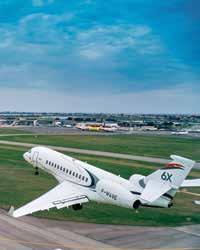


Tshering Tobgay, Prime Minister, Bhutan

1 ISSUE 6 • 2024 www.sps-aviation.com ENGINES 12 Technology CFM RISE — Full Speed Ahead! 22 CFM 50 Million LEAP SHOW REPORT 15 EBACE2024 A showcase of the Latest Technological Advancements in BizAv CIVIL 25 Airliners Slow Fade of the Four-Engine Airliner REGULAR DEPARTMENTS 2 From Editor-in-Chief 28 Hall of Fame Si Spiegel (1924-2024) 29 NewsDigest 32 Last Word Push AI for Better Safety MILITARY 3 Unmanned
Unmanned
is Unfolding SPACE 6 Tourism Journey to the Beyond
EXCLUSIVE INTERVIEW 9 India-Bhutan
COVER IMAGE
How the Future of
Military Aircraft
DIPLOMACY
DESIGN
NEXT ISSUE: Farnborough International Airshow 2024 Preview TABLE OF CONTENTS VOL 27 ISSUE 6 • 2024 PUBLISHER AND EDITOR-IN-CHIEF
COVER
WWW.SPGUIDEPUBLICATIONS.COM Awards 2017 SPECIAL CONTRIBUTION TO BUSINESS AVIATION SHARP CONTENT FOR A SHARP AUDIENCE SP’s 100.00 (INDIA-BASED BUYER ONLY) AN SP GUIDE PUBLICATION aviation www.sps-aviation.com & FALCONS RULE MILITARY FUTURE OF UNMANNED MILITARY AIRCRAFT ENGINES 50 MILLION FLIGHT HOURS OF LEAP EXCLUSIVE "WE ARE A CLOSE NEIGHBOUR AND FAMILY BUT OUR FRIENDSHIP IS SPECIAL. BECAUSE NOT JUST TO THE TEST OF TIME BUT OVER THE DECADES IT HAS BEEN GOING FROM STRENGTH TO STRENGTH. WHAT DRIVES OUR FRIENDSHIP IS OUR LEADERSHIP." — TSHERING TOBGAY, PRIME MINISTER, BHUTAN SPACE TOURISM JOURNEY TO THE BEYOND MUCH MORE... PAGE 15 EBACE '24 WITNESSED THE FALCON FAMILY, INCLUDING 6X, 8X, 2000LXS AND 10X, BEING SHOWCASED RNI NUMBER: DELENG/2008/24199 SPACE TOURISM WITH SPACE BALLOON

The integration of Tactical AI and machine learning in defence projects is enhancing the performance and portability of high-performance capacities across various military platforms. In this issue, Manish Jha details how the future of Unmanned Military Aircraft is unfolding with the use of these cutting-edge technologies.
Recently, Blue Origin completed its seventh human spaceflight and the 25th flight for the New Shepard programme. This flight was an example of the expanding possibilities of people going to space. In this edition of the magazine, Ayushee Chaudhary throws light on space tourism with its challenges and excitement through recent developments and missions. Though currently accessible only to billionaires, it holds the potential to expose a wider set of people to the views of earth’s horizon and zero-G experiences in the future.
In his exclusive interview to Manish Kumar Jha in Thimphu, Tshering Tobgay, Prime Minister of Bhutan talks about

SP Guide’s Manish Jha travelled to Bhutan for an exclusive interaction with the Prime Minister of Bhutan over a range of issues which further reaffirm Bhutan’s historic bilateral relations with India
various issues and the roadmap for Bhutan, embracing new, and advanced technologies for emerging Bhutan. Bhutan holds a unique position providing an alternative model of development and despite the economic pressure within, the country is sticking towards its sustainability programme.
The issue also provides a detailed report of EBACE2024, one of the largest gatherings for the business aviation industry in Europe that concluded after a grand celebration of the industry’s advancements. The show underlined significant deals, displays, announcements, technical advancements, innovation in the aviation industry and its focus on sustainability.
In his article, Joseph Noronha highlights that revolutionary new engine designs and cutting-edge technologies are essential to achieve net zero carbon emissions goal by 2050. The CFM International RISE is one such programme that with its various RISE technologies is steadily evolving from promising design concepts to functioning components and systems. Alongside RISE, in this edition, Ayushee Chaudhary also brings the CFM LEAP engine family to the forefront as it achieved 50 million flight hours.
In his Last Word, Rohit Goel points out how new horizons for safety enhancements, like the use of Artificial Intelligence, should be continually explored and implemented in the aviation industry.
All this and more in this issue of SP’s Aviation. Welcome aboard and we wish you many happy landings!
 JAYANT BARANWAL PUBLISHER & EDITOR-IN-CHIEF
JAYANT BARANWAL PUBLISHER & EDITOR-IN-CHIEF
2 ISSUE 6 • 2024 www.sps-aviation.com A WORD FROM EDITOR-IN-CHIEF
FOLLOW US ON Owned, published and printed by Jayant Baranwal, printed at Kala Jyothi Process Pvt Ltd and published at A-133, Arjun Nagar (Opposite Defence Colony), New Delhi 110003, India. All rights reserved. No part of this publication may be reproduced, stored in a retrieval system, or transmitted in any form or by any means, photocopying, recording, electronic, or otherwise without prior written permission of the Publishers. SPPublications @SPsAviation
PHOTOGRAPH: PMO BHUTAN
PRIME MINISTER OF BHUTAN TSHERING TOBGAY IN CONVERSATION WITH MANISH K. JHA (CONSULTING & CONTRIBUTING EDITOR) AT PMO, THIMPHU, BHUTAN

THE X-62A, ALSO KNOWN AS VARIABLE IN-FLIGHT SIMULATION TEST AIRCRAFT (VISTA) PROGRAMME, INCORPORATES MACHINE LEARNING AND HIGHLY SPECIALISED SOFTWARE TO TEST AUTONOMOUS FLYING
HOW THE FUTURE OF UNMANNED MILITARY AIRCRAFT IS UNFOLDING
The integration of Tactical AI and machine learning in defence projects is enhancing the performance and portability of high-performance capacities across various military platforms
By MANISH KUMAR JHA
The Advanced militaries of the world have been increasing efforts to develop trusted autonomy capabilities for their aircraft fleet. For example, leading the race is the US Department of Defense (DoD), working on several programmes
to enable the operation of their in-service aeroplanes by using artificial intelligence (AI) and machine learning (ML) software.
Showing the commitment and vision towards autonomous capability, Frank Kendall, the Secretary of the Air
3 ISSUE 6 • 2024 www.sps-aviation.com MILITARY UNMANNED
PHOTOGRAPH: US AIR FORCE
Force, recently flew in the front seat of an X-62A Variable In-flight Simulation Test Aircraft in California. The concept called –VISTA—was tested at the Air Force base.
Interestingly, for the entire flight journey, the aircraft was not piloted and remained untouched. In fact, it was aimed to demonstrate various tactical manoeuvres under the control of highly specialised software to test autonomous flying and other advanced capabilities. The project was a result of further collaboration between the Defense Advanced Research Projects Agency (DARPA) and the US Air Force (USAF). This is dubbed as part of DARPA’s Air Combat Evolution (ACE) programme.
At the core remains technologies called Tactical AI, a software product and a design philosophy to build highperformance capacities that are portable between platforms.
Another is the unmanned aerial vehicle (UAV) experts at Aurora Flight Sciences which are moving forward with developing an X-plane to demonstrate enabling technologies in speed and runway independence for future crewed and unmanned aircraft.
The DARPA announced a $25 million order to Aurora Flight Sciences for the Speed and Runway Independent Technologies (SPRINT) programme. Last Year, in the bid for such a scale of autonomous aircraft Aurora managed to present the concept of demonstrator, under the DARPA SPRINT. Other companies taking part in the DARPA SPRINT programme’s first phase are Bell Textron; Northrop Grumman Aeronautic Systems and Piasecki Aircraft.
THE X-PLANE – NEXT-GENERATION AUTONOMOUS AIRCRAFT
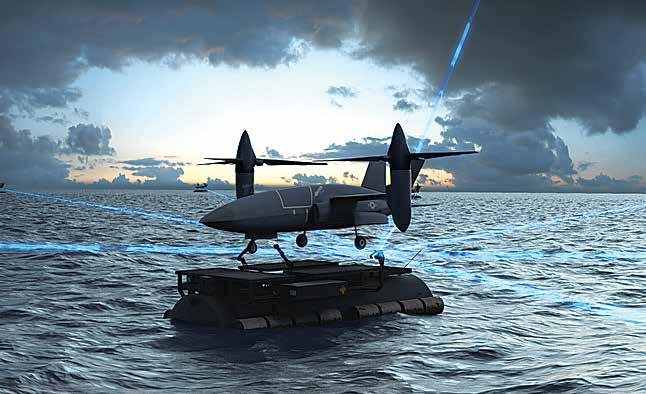
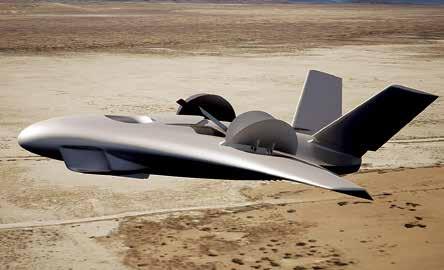
Such an advanced level of autonomous systems is based on an X-plane to prove the technologies which could also be tested for aircraft speed. Later it is further aimed to improve, design, build, certify, and fly for the next generation of crewed and unmanned aircraft.
By April 2027, Aurora hopes to have the demonstrator in the air for the first time and validate the enabling technologies at a scaled experimental X-plane demonstrator. After concentrating on conceptual design initially, Aurora engineers will now work on a few chosen X-plane designs before moving on to limited detailed design.
So, the key aspect is to achieve the required speed of 450 to 500 knots, and manoeuvre at such speed with all existing possibilities in terms of testing.
Rather than serving as a pre-production aircraft, the SPRINT X-plane is intended to serve as a proof-of-concept technology demonstrator, allowing the validation of technologies that can be applied to a range of military aircraft sizes.
After the DARPA flight demonstration, the runway-independent SPRINT X-plane should still have useful flight hours and will probably be given to the US Special Operations Command for additional assessment.
The X is also a VTOL X-Plane technology demonstrator intended to achieve a top sustained flight speed of 300 kt-400 kt and Raise aircraft hover efficiency from 60 per cent to at least 75 per cent.
It also aimed to present a more favourable cruise lift-todrag ratio of at least 10, up from 5-6 and carry a useful load of at least 40 per cent of the vehicle’s projected gross weight of 10,000-12,000 pounds
Together with the members of Aurora’s team, Rolls-Royce PLC and Honeywell, the technology demonstrator was designed. With the demonstration aircraft, the Aurora-led team hopes to accomplish several aviation firsts, such as being the first to be designed to demonstrate Distributed ducted fans with hybridelectric propulsion systems.
4 ISSUE 6 • 2024 www.sps-aviation.com MILITARY UNMANNED
PHOTOGRAPHS: BELL TEXTRON, AURORA FLIGHT SCIENCES
THE SPRINT PROJECT AIMS TO DESIGN, BUILD, AND FLY AN EXPERIMENTAL AIRCRAFT (X-PLANE) TO DEMONSTRATE TECHNOLOGIES FOR THE NEXT GENERATION OF AIR MOBILITY PLATFORMS. (TOP) BELL TEXTRON X-PLANE; (ABOVE) AURORA’S LATEST X-PLANE DESIGN.
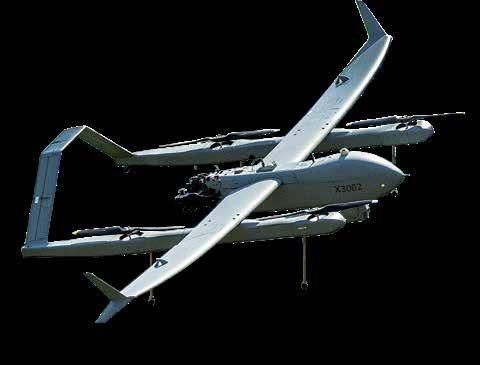
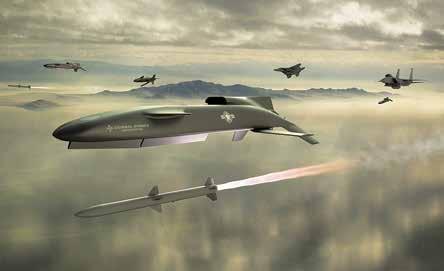
(TOP) PURPOSE-BUILT TO MEET THE US ARMY’S FUTURE VERTICAL LIFT REQUIREMENTS TEXTRON’S AEROSONDE MK. 4.8 HYBRID QUAD (HQ) UAS IS RUNWAY INDEPENDENT; (ABOVE) GA’S LONGSHOT PROGRAMME IS CENTERED ON DEVELOPING AN AIR-TO-AIR MISSILEARMED DRONE THAT FIGHTERS AND BOMBERS CAN LAUNCH AND CONTROL.
This is groundbreaking aviation according to a senior Honeywell official. What is so radical about such innovation is that it significantly improves electric power-generation efficiency, power density and size. Further as the officials point out it would raise the bar for electric power-generation efficiency that would enable this revolutionary advance in hybrid-electric aircraft propulsion.
It adds a cutting-edge synchronous electric drive setup with high-efficiency vertical takeoff and landing propulsion systems using both tilt-wing and tilt-canard technology for both hovering and fast forward flight.
FUTURE TACTICAL UNCREWED AIRCRAFT SYSTEM (FTUAS) PROGRAMME
Textron’s Future Tactical Uncrewed Aircraft System (FTUAS) Programme is also gearing up for the competition.
FTUAS provides an organic capability to conduct reconnaissance and surveillance operations that collect, develop, and
report actionable intelligence, allowing the War fighter to maintain dominance during Multi-Domain Operations. According to the US army, in summary, FTUAS provides transformational capabilities including, VTOL for runway independence, On-The-Move command and control, Soldier led field level maintenance, and enables rapid capability insertions, further allowing the system to keep pace with technology.
After finishing the FTUAS programme, Textron will proceed to improve its suggested design in accordance with the Modular Open System Approach (MOSA) standards set forth by the Army, culminating in a critical design assessment. Textron Systems is providing the Aerosonde Mk. 4.8 Hybrid Quad (HQ) unmanned aircraft system (UAS) for the programme.
How far such initiates are able to realise the steps towards a robust system? Here, for example, Aerosonde HQ has already proven its interoperability in addition to achieving the crucial operational agility. So far, with over 35 separate payload integrations and the ability to carry multiple payloads simultaneously, the Aerosonade is rapidly deploying and testing its data-proven autonomous elements.
The multi-payload capabilities of the Aerosonde Mk. 4.8 HQ, designed for the Army’s Brigade Combat Teams (BCTs), provides these units at the tactical edge with more options when it comes to outfitting the sensors required for the task and the surrounding conditions. The statement from their representatives claims that Textron Systems’ ongoing commitment to integrating and showcasing payloads offers a low-risk way to satisfy the Army’s requirements.
In a statement, Wayne Prender, Senior Vice President of Air Systems at Textron explained that with 30+ years of UAS experience accumulated over three million flight hours, they have established a mature, reliable and ready ecosystem to support our Army customer. He further outlines that the system is designed in a way to be adaptable so that as technology evolves, the Aerosonde UAS can support the soldiers not only in the near term but in the future as well.
As to the official announcement, the Aerosonde HQ platform is capable of handling several missions and is based on a family of systems that have accumulated more than 6,00,000 flying hours. The SWAP profile of the aircraft is designed to maximise its capabilities, including wide-area surveillance, full-motion video capture in both day and night, communications relay, signals intelligence, and more. SP
Manish Kumar Jha is a Consulting & Contributing Editor for SP’s Aviation, SP’s Land Forces and SP’s Naval Forces and a security expert. He writes on national security, military technology, strategic affairs & policies.
5 ISSUE 6 • 2024 www.sps-aviation.com MILITARY UNMANNED
PHOTOGRAPHS: TEXTRON SYSTEMS, GENATOMICS_ASI / X

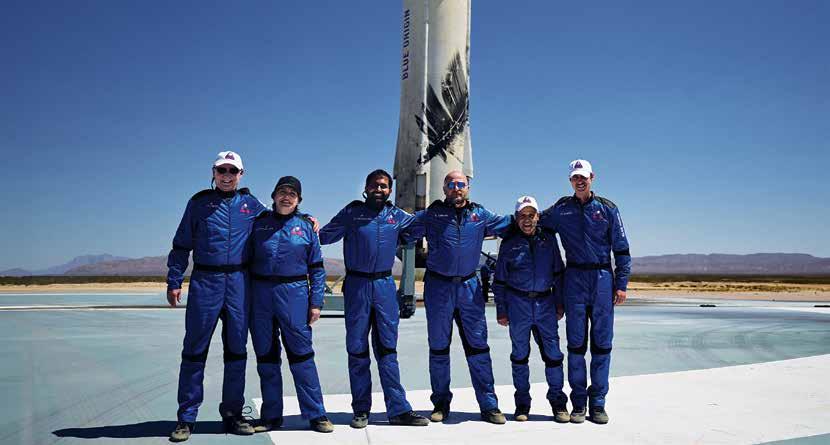
JOURNEY TO THE BEYOND
Space tourism with its challenges and excitement, currently accessible only to billionaires, holds the potential to expose a wider set of people to the views of earth’s horizon and zero-g experiences in the future
By AYUSHEE CHAUDHARY
Recently, Blue Origin completed its seventh human spaceflight and the 25th flight for the New Shepard programme. The flight carried astronauts Mason Angel, Sylvain Chiron, Kenneth L. Hess, Carol Schaller, Gopi Thotakura, and former Air Force Captain Ed Dwight. Dwight, who was selected as the nation’s first Black astronaut candidate, never had the opportunity to fly until now at the age of 90. His flight was an example of the expanding possibilities of people going to space. With this flight, New Shepard has flown a total of 37 people into space.
The journey aboard Blue Origin’s spacecraft lasted about ten minutes. While this was one of the shortest trips to space, this flight restarted the conversation around space tourism, its charm, its feasibility, etc. This flight was a sub-orbital space-
flight, which crossed the Karman line, the 100 km boundary of space, before descending back to Earth. Most current space tourism offerings are similar sub-orbital flights, but longer journeys are also available, including orbital flights that can involve spending days on the International Space Station (ISS). The first space tourist, Dennis Tito, spent over seven days on the ISS in 2001. According to NASA, the first private astronaut mission to the station was Axiom Space’s Axiom Mission-1 that carried four astronauts aboard a SpaceX Dragon spacecraft named Endeavour. 13 private visitors, known as spaceflight participants, from seven countries have visited the orbital outpost.
While on one hand, there was a ray of optimism for space tourism through the Blue Origin mission, on the other hand we
6 ISSUE 6 • 2024 www.sps-aviation.com
PHOTOGRAPH: BLUE ORIGIN
NEW SHEPARD’S 25TH FLIGHT (NS-25) ASTRONAUTS POSE IN FRONT OF THE NEW SHEPARD BOOSTER. (LEFT TO RIGHT): KENNETH L. HESS, CAROL SCHALLER, GOPI THOTAKURA, SYLVAIN CHIRON, ED DWIGHT AND MASON ANGEL.
witnessed the announcement of cancellation of the dearMoon mission, highlighting the challenges that space tourism endures. Originally booked in 2018 for a 2023 launch, the project, named dearMoon, was scrapped due to delays in Starship’s development. Despite SpaceX’s advancements, including an uncrewed test reaching orbital velocity in March 2024, Starship has not yet completed a successful mission. Starship has yet to fly to the moon, carry people, or achieve orbit. Maezawa was announced as the first customer for SpaceX’s Starship in September 2018 and has made a significant down payment. Originally, the mission was slated for 2023. SpaceX is focused on making Starship operational for a crewed lunar landing under NASA’s Human Landing System contract and to support Starlink satellite launches. SpaceX is preparing for a fourth integrated test flight of Starship/Super Heavy to demonstrate that both stages can return to the surface without breaking apart.
Currently, the high costs of space travel restrict it to highnet-worth individuals. However, as technology advances, prices are expected to decrease, making space tourism more accessible. More affordable options, such as high-altitude balloon flights offering views of the Earth’s curvature, are also emerging. The rapid development of space tourism reflects growing public interest and investment, suggesting a promising future for this industry. As it continues to evolve, space tourism is set to become a more attainable dream for many, expanding the horizons of human exploration and adventure.
JOURNEY TO THE EDGE OF EARTH
In 2021, Virgin Galactic, Blue Origin, and SpaceX launched their inaugural private space tourism missions. Virgin Galactic and Blue Origin sent their CEOs, Richard Branson and Jeff Bezos, into suborbital space within 10 days of each other, offering a few minutes of weightlessness. SpaceX facilitated a chartered flight by billionaire Jared Isaacman using its Crew Dragon spacecraft. Isaacman and three companions orbited Earth for three days without professional astronaut assistance, marking a first in space tourism. Maezawa also made headlines by spending 12 days aboard the ISS via the Russian Soyuz spacecraft. These initial flights, largely chartered by billionaires, revamped the way for space tourism.
The costs for each of these flights are without question only for high-net worth individuals for now. However, despite the challenges in space travel, the hope is that the prices will come down, democratising space travel and making it accessible and affordable to more and more people. Some companies offer high-altitude balloon rides, reaching heights of about 1,00,000 feet for $50,000, allowing passengers to see the curvature of the Earth without experiencing weightlessness. While the exact costs can be known once you apply for any of these flights and contact the respective companies, reports suggest that a similar journey (like that of Blue Origin’s recent flight) on Virgin Galactic costs about $4,50,000 (about `3.75 crore). A journey to the ISS can range between 20 to 25 million dollars (about `160 to 210 crore). SpaceX and Space Adventures plan lunar trips costing $70 to $100 million (about `600 to 850 crore).
Virgin Galactic aims to offer regular suborbital flights with its VSS Unity spaceplane. Despite delays and setbacks, they are moving closer to commercial flights with an extensive waitlist and a £2,00,000 deposit requirement. While SpaceX plans lunar tourism with future missions, including sending paying customers around the Moon. And Blue Origin aims to use its New Shepard rocket for suborbital flights and plans to offer orbital flights.
Apart from the three companies mentioned above, many others are also facilitating taking humans to space. While some


are working on rockets and balloons to allow space travel, some others are working on creating space stations and space hotels for habitation. An Indian company like Space Aura plans to take humans to the edge of space in its space balloon. Through NASA’s Commercial Crew Development programme, Boeing is also developing the CST-100 Starliner capsule, allowing them to sell seats to tourists, ensuring at least one tourist per mission. Axiom Space organises private flights to the ISS, priced at $55 million per trip. Companies like above are working on creating space architecture. Voyager Station is in talks to become the first space hotel. While these missions are capital intensive, and spread across long timeliness, these companies are making significant strides in offering options for those eager to venture beyond Earth’s boundaries and experience the overview effect of looking at the Earth’s horizon against the darkness of space.
CHALLENGES TO REACH ABOVE & BEYOND
Space tourism, while exciting, faces several significant challenges. The foremost hurdle is the cost. Safety is another critical concern. Space travel inherently involves high risks, as evidenced by several high-profile rocket failures. Ensuring passenger safety requires rigorous testing and failsafe measures, which are both time-consuming and expensive.
Additionally, the environmental impact of more such flights when they become frequent might also arise. However, the fact that reusability is at the centre of the technologies being developed by companies including SpaceX and Blue Origin for their space
7 ISSUE 6 • 2024 www.sps-aviation.com SPACE TOURISM
PHOTOGRAPHS: BLUE ORIGIN, SPACE AURA
(TOP) ASTRONAUT GOPI THOTAKURA CELEBRATES A SUCCESSFUL MISSION TO SPACE; (ABOVE) SPACE AURA SPACESHIP FLOATING ABOVE EARTH.


flight gives a better hope for sustainable space travel in the future.
Lastly, the physical demands on passengers are significant. Even short suborbital flights expose travelers to high G-forces and require them to be in good health. While the bracket of people who can now go to space is expanding, it is still crucial. Comprehensive training is necessary to prepare tourists for the physical and psychological stresses of space travel, which adds another layer of complexity to the industry.
Virgin Galactic’s tragic accident in 2014, where a test flight crashed, underscored the risks involved. Similarly, SpaceX has faced setbacks, including the explosion during the uncrewed Starship test flight in April 2023. Blue Origin also had to address safety concerns after a booster failure during a cargo mission in 2022.
Overcoming these challenges will be crucial for the future growth and sustainability of space tourism. Companies are making strides, but the path forward involves continued innovation, investment, and attention to safety and environmental impacts.
ASTRONAUTS & SPACE TOURISTS
The rigorous training for professional astronauts traveling to the ISS or undertaking longer missions to the moon and beyond is far more extensive than that for space tourists. However, space tourists, who also experience becoming astronauts, still undergo essential training, including understanding mission procedures, safety systems, zero-gravity protocols, and participating in mission simulations, etc. While suborbital flights require minimal training included in the ticket price, more extensive training is necessary for orbital and ISS missions. Despite the differences, both astronauts and space tourists undergo physical and psychological preparation and share the profound “overview effect,” a cognitive shift in awareness upon seeing Earth from space, fostering a sense of global unity and environmental consciousness.
SPACE TOURISM MARKET
The global space tourism market was valued at $851.4 million in 2023 and is projected to reach $555 million by 2030, according to German data platform Statista. The space economy encompasses all activities and resources that create value and benefits for humanity through space exploration, research, understanding, management, and utilisation, as defined by the Organisation for Economic Cooperation and Development (OECD). This includes all public and private sectors involved in
developing, providing, and using space-related products, services, and scientific knowledge. Space tourism is a small yet growing segment within this larger industry. Trends such as increasing public interest, rising private investment in space ventures, and growing industry revenues suggest that the space industry could become the next trillion-dollar industry by 2040.
• Morgan Stanley estimates that the global space industry could generate revenue of more than $1 trillion in 2040.
• UBS says by 2030 travel via outer space will reach $20 billion/year, competing with long-distance airline flights.
• NASA recently funded three companies to develop commercial space stations, totaling $415M.
Technological advancements and rising interest in space access are driving the growth of the space tourism market. Space tourism is now a reality and despite the challenges and high risks, as companies innovate and improve efficiency, the cost of space travel is expected to decrease over time.
Space tourism has a long history, but it took decades for technology, public interest and private companies to align towards making it feasible. Lower launch costs and diverse options have fueled interest among the wealthy, potentially transforming the space sector. Despite initial skepticism, space tourism is projected to become a $12.7 billion industry by 2031.
A recent report by the World Economic Forum underlined that by 2035, new commercial activities such as manufacturing and tourism are likely to become possible and expand in space. The growth of the space tourism industry will depend on several factors, including the capacity to accommodate people in orbit, regulation and legislation, and interest from end-users. Until 2035, the market size is expected to remain capped at around $4-6 billion per year, with most of the space tourism revenues coming from in-orbit stays aboard space stations as ultra-high-net-worth customers purchase their space travel experience. Sub-orbital flights are expected to continue and become more financially accessible, but will represent only a small share of the market (no more than $1-2 billion per year by 2035). As space tourism edges closer, research on long-term human habitability in space will gain traction, unlocking new markets and areas of research.
While space tourism is still in its early stages, the vision of making it accessible to a broader audience is becoming increasingly realistic. As advancements continue and costs decrease, the dream of reaching the edge of space is moving closer to reality. This shift promises exciting times ahead and significant growth for the space industry. SP
8 ISSUE 6 • 2024 www.sps-aviation.com SPACE TOURISM
PHOTOGRAPHS: NASA, ABOVESPACEDEV / X
(LEFT) BOEING’S STARLINER SPACECRAFT APPROACHES THE INTERNATIONAL SPACE STATION; (RIGHT) VOYAGER STATION IS IN TALKS TO BECOME THE FIRST SPACE HOTEL.

9 ISSUE 6 • 2024 www.sps-aviation.com
INDIA-BHUTAN
DIPLOMACY
EXCLUSIVE PHOTOGRAPH: PMO BHUTAN
TSHERING TOBGAY, PRIME MINISTER, BHUTAN
“OUR FOCUS AND PRIORITY ARE TO NURTURE THE FRIENDSHIP WITH INDIA WHEN IT COMES TO INTERNATIONAL RELATIONS”
— TSHERING TOBGAY, PRIME MINISTER OF BHUTAN
In a very exclusive interaction, Manish Kumar Jha speaks with Prime Minister Tshering Tobgay in Thimphu, Bhutan over the range of issues which will further reaffirm the historic bilateral relations with India
India and Bhutan are the closest partners. In fact, India, and Bhutan’s partnership span across economic, security as well as cultural ties. The historic partnership is unfolding in a new era in different dimensions. Although small in size, Bhutan holds a unique position providing an alternative model of development and despite the economic pressure and dimensions within, Bhutan is sticking towards its sustainability programme.
Manish Jha (Jha): India-Bhutan relations are the closest between the two neighbours despite deferring in size vastly. What is behind such relations?
Prime Minister Tshering Tobgay (PM Tobgay): Yes, we are a close neighbour and family but our friendship is special. Because not just to the test of time but over the decades it has been going from strength to strength. What drives our friendship is our leadership. In this case, it is our successive enlightened monarchs who have nurtured our friendship with India and ensured that our friendship grows from strength to strength.
In India, it is your successive Presidents and Prime Ministers and most recently, Prime Minister Narendra Modi. Under his tenure, the friendship between our two countries has grown to unprecedented levels. And this is why I say our friendship is special. It is unique. It is an example of good neighbourliness and good friendship for the rest of the world and that friendship is developed, nurtured, and maintained.
Jha: Prime Minister, the leadership in Bhutan in the democratic setup charted its economic development path. It is based on the alternative model of the Gross Happiness
“Under
Index which is the measurement of Bhutan’s economic development. While accepted, it is also debated. Could you talk about the economic progress? How is it unfolding?
PM Tobgay: Gross national happiness puts the happiness and well-being of our people at the centre of the development agenda. Gross national happiness attempts to balance economic growth. Economic growth is important, that’s undeniable. But economic growth must be balanced with social progress equity, environmental preservation, culture and good governance. This holistic form of development is the so-called gross national happiness, and we attempt to be true to the ideals and principles of gross national happiness in developing our economy.
Are we there yet? Not by a long shot! We have a lot to do in strengthening our economy and growing our economy and in doing so we aspire to continue to be faithful to the principles and ideals across National happiness that has gotten us this far.
Jha: Bhutan’s concerns for the environment are globally recognised as the only carbon-negative country. It is also a difficult debate against the demand for urban modernisation and Industrial expansion. What is your model for future sustainability in that case?
Prime Minister Narendra Modi, the friendship between our two countries has grown to unprecedented levels.”
PM Tobgay: Well, we are fortunate. And we are proud that we are. About the negative carbon country, as you pointed out, we are just 1 of 3 countries worldwide the other two being Panama and Suriname. Then being a carbon negative, we were the first to be recognized as such. We are a carbonnegative [Country] because of the enlightened leadership and enlightened policies of our kings. We are carbon-negative because of the ideals of gross national happiness.
10 ISSUE 6 • 2024 www.sps-aviation.com DIPLOMACY INDIA-BHUTAN

We aspire to continue to be carbon-negative as we continue to grow in our development Journey. Urban living does not necessarily have to be environmentally destructive. We can have a middle path where people can live in an environment space which is respectful of one another and is respectful.
His Majesty, the King’s Royal vision of a city that will be spread across more than 2,000 square kilometres, which will encompass at least two of our ancient protected areas. That’s going to be carbon negative and that is going to be one of the most sustainable cities in the world. To assume the middle path between urban growth, urban living and natural sustainability. In Bhutan, we have the upper hand because it is basically, an extension of gross national happiness.
Jha: Bhutan’s thrust on clean energy especially in the sectors of hydropower, solar and green hydrogen is a priority. Could you talk about the road map for further growth based on clean and green energy?
PM Tobgay: Well except for a few outliers, in the world, almost everybody has accepted, that green energy is important, that we cannot continue to depend on fossil fuels that this is bad for our planet--bad not just for the future but for ourselves closer to our home. And so, a similar intensity in focusing on green energy in Bhutan. We are blessed because in the Himalayas we have a lot of fast-flowing rivers which can generate more than 30 gigawatts of clean energy. We have generated 30,000 megawatts of clean energy and so far. While we are already exporting electricity to India. We have tapped only 7.5 per cent of our potential. We are going to accelerate the development of hydropower production in the country. Plus, we are accelerating the development of solar.
Jha: Bhutan is also embarking on an ambitious plan towards rapid socio-economic progress and technological advancement
with new and emerging technologies. What are the challenges in terms of funding and skill development? And how are you progressing? What’s your vision?
PM Tobgay: Well, we don’t have a choice. We have to adapt. Digital advancement does not just adopt digital technology but uses it in a relevant way. But remember, technology is not the goal. The idea is to leverage technology and use technology to grow mindfully and to enhance the happiness and well-being of our people. Now, because we have a small economy and a small population of just 7 lakh people, the per capita cost becomes prohibitive and this is very expensive for us. But, that said, we don’t have a choice. We must adopt and yes — relevant technologies. And for this, we must prioritise our investments and one of the priorities is digital technology.
Jha: How does Bhutan manage its diplomatic role amid such volatile situations worldwide? It’s often seen as a role model in terms of managing and navigating the clumsy geopolitics today. What is behind that secret?
PM Tobgay: Our main friend, a principal ally is India. To a large degree, our focus and our priority are to nurture the friendship with India when it comes to international relations. Besides India, we have diplomatic relations with only a select number of countries. And with them, we maintain good relations. In fact, we have very few diplomatic missions. It is only a handful of places in the world. And each of those missions look after multiple countries. And they are overstretched. But this is after all a small country, can we engage meaningfully? We sincerely deal with as many countries as possible and we use the multilateral organisations, the UN for example, to engage at a multilateral level to the extent possible. SP
This is an abridged version. For the complete version of the interview, visit www.sps-aviation.com
11 ISSUE 6 • 2024 www.sps-aviation.com DIPLOMACY INDIA-BHUTAN
PHOTOGRAPH: PIB
PRIME MINISTER NARENDRA MODI WITH THE PRIME MINISTER OF BHUTAN, TSHERING TOBGAY AT THIMPHU, IN BHUTAN ON MARCH 22, 2024.
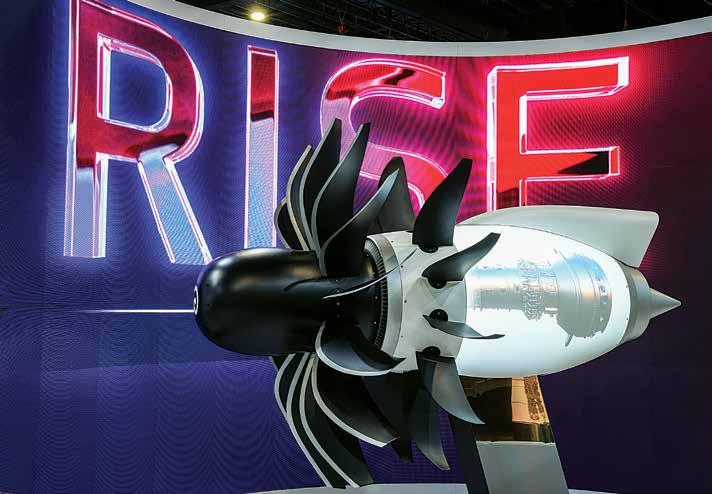
CFM RISE — FULL SPEED AHEAD!
Three years into the programme, it is clear that various RISE technologies are steadily evolving from promising design concepts to functioning components and systems. And the pace of progress is accelerating.
By JOSEPH NORONHA
There is a growing realisation in the aviation industry that it cannot possibly reach its net zero carbon emissions goal by 2050 by banking solely on sustainable aviation fuel (SAF) and incremental improvements in fuel efficiency. Revolutionary new engine designs and cutting-edge technologies are essential. And CFM International, a 50-50 joint venture between two of the world’s leading aerospace companies –General Electric Aerospace (GE) and Safran Aircraft Engines (SAE) – has always been in the forefront of engine design and technological innovation.
12 ISSUE 6 • 2024 www.sps-aviation.com ENGINES TECHNOLOGY
CFM
ENGINES) PROGRAMME WILL DEMONSTRATE AND MATURE A RANGE OF NEW, DISRUPTIVE TECHNOLOGIES
ENGINES THAT WILL TAKE THE NEXT GENERATION OF SINGLE-AISLE AIRCRAFT TO A NEW LEVEL OF FUEL EFFICIENCY AND REDUCED EMISSIONS.
RISE (REVOLUTIONARY INNOVATION FOR SUSTAINABLE
FOR FUTURE
PHOTOGRAPH: GE_AEROSPACE / X
CFM’s very first product, the CFM56, was a high-bypass turbofan engine that entered service in 1982, and brought a significant jump in fuel efficiency over other jet engines of the era. It eventually became the most successful commercial aviation engine in history. Not content to rest on its laurels, CFM introduced the LEAP engine in 2016. Over the past eight years LEAP has done exceedingly well, delivering 15 to 20 per cent better fuel efficiency than the CFM56-5B and CFM56-7B engines. In sales, it has left the competition far behind.
In fact, CFM’s engines are the primary choice of single-aisle aircraft operators around the world. Currently CFM has about 39 per cent market share, which makes it the largest commercial aircraft engine manufacturer in the world. But with climate change taking centre stage in practically every major forum, another step change in aero engine efficiency is urgently required. Enter the CFM RISE programme.
RISE’S BUILDING BLOCKS
Source: CFM
The CFM International RISE (Revolutionary Innovation for Sustainable Engines) Technology Demonstration Programme was launched on June 14, 2021. Its goals include reducing fuel consumption and carbon emissions by more than 20 per cent compared to today’s most efficient engines, as well as ensuring compatibility with alternative energy sources like SAF, electricity and hydrogen. It incorporates several technological innovations aimed at improving the efficiency, performance, and sustainability of aircraft engines. The 35,000lb (156kN)-thrust class RISE programme will allow CFM to mature the technologies required for a new single-aisle engine to potentially enter service in the mid-2030s.
RISE’s main features include:
• Open Fan: RISE features an innovative 13-foot-diameter open fan which will enable a much higher bypass ratio and probably bring the single greatest engine efficiency increase that CFM has ever achieved. While noise is an inherent drawback of the open fan architecture, RISE incorporates several measures to reduce noise levels to below the permissible value.
• Compact high-pressure core: A high-power gear system and a new compact high-pressure (HP) core will boost thermodynamic efficiency.
• Sustainable Aviation: RISE will be more environmentally friendly than other engines by improving fuel efficiency, reducing carbon emissions, and minimising noise pollution. Compatibility with alternative fuels is a key requirement.
• Advanced Materials: RISE integrates cutting-edge technologies such as ceramic matrix composites (CMCs), 3D printing, and advanced manufacturing techniques to enhance engine performance and efficiency. Composite blades are GE’s forte. Having introduced composite fan blade technology commercially with the GE90 engine back in 1995, GE has totalled more than 100 million engine flight hours with such blades.
• Hybrid-Electric Propulsion: The RISE programme is exploring the integration of hybrid-electric propulsion systems with single-aisle engines, aiming to further reduce emissions and fuel consumption.
• Real-time Engine Monitoring: Performance optimisation and predictive maintenance, including advanced engine
CFM RISE PROGRAMME

health monitoring systems and data analytics capabilities will be inbuilt so as to extract the maximum possible advantage from the engine.
• Commercialisation: The ultimate goal of the RISE programme is to develop engines that meet all regulatory certification requirements and are ready for commercial exploitation.
TESTING TIMES
With more than 1,000 engineers deployed on the CFM RISE, the programme is supported by CFM’s most comprehensive testing roadmap yet. Work is progressing simultaneously on multiple fronts.
• In January 2024, SAE announced that wind-tunnel tests of the scaled ECOENGInE had begun at facilities run by French aerospace research agency ONERA. The tests are to support the maturation of the open-fan’s aerodynamic and acoustic performance. Ingestion tests have already been performed on open rotor fan blades. According to SAE’s Pierre Cottenceau, around two-thirds of the planned 200h of testing have been completed. He added, “I would say generally we are very happy with the test results… (which) have come out a bit better than predictions.” The first full open fan demonstrator engine is expected to start ground testing in 2025-26, with another pair of engines due to start flight testing around two years later with Airbus.
• Earlier, in 2023, to simulate air movement of a full-scale open fan design in intricate detail, GE Aerospace created special computational fluid dynamics software and ran it on Frontier, the supercomputer of the US Department of Energy’s Oak Ridge National Laboratory. Frontier is the world’s fastest supercomputer and can make more than a quintillion calculations per second.
• Acoustic performance is crucial during cruise conditions, in which low cabin noise is the primary goal. CFM claims that it has made significant progress in acoustics, and that the open fan noise levels are already on the lower end required for certification.
13 ISSUE 6 • 2024 www.sps-aviation.com
ENGINES TECHNOLOGY
Revolutionary
Targeting More than 20% Lower CO2 Emissions Step change in propulsive efficiency Build on proven technologies Hybrid-electric Advancing open fan architectures 100% SAF, hydrogen capability Advanced materials Technology Maturation Ground & Flight tests EIS by the mid-2030s
Innovation for Sustainable Engines
MAJOR TESTING, FIRST FORGINGS
Great Progress Since 2021 Programme Launch

l Fan blades: static & dynamic tests, including ingestion and vibration
l Open fan scale model wind tunnel test
l High-speed low-pressure turbine test
l First manufactured parts

l Deploying supercomputing capability combined with state-of-art system testing with Airbus*
l Improving cabin noise experience to exceed passenger expectations
• Tests on RISE’s next-generation high-pressure turbine, which were recently conducted at GE headquarters in Evendale, Ohio, confirmed that it can deliver significant fuel efficiency improvements and increased durability. The technology will be useful in the compact core GE Aerospace is developing for the RISE programme through NASA’s Hybrid Thermally Efficient Core (HyTEC) programme, which has so far focused on high-pressure compressor and high-pressure turbine advanced aerodynamics, along with work on the combustor. However, to shrink the size of the core while maintaining the same level of thrust, both heat and pressure must increase compared to conventional jet engines. This means the engine core must be made of more durable composite materials that can withstand higher temperatures. The CMC parts that GE has developed over the past decade are one-third the weight of steel but can withstand temperatures as high as 1,300 degrees Celsius, which is beyond the melting point of many advanced metallic superalloys.
• Tests have been conducted at NASA’s Electric Aircraft Testbed facility in Sandusky, Ohio, as part of NASA’s Electrified Powertrain Flight Demonstration (EPFD) project. These tests have validated GE’s hybrid-electric propulsion system architecture approach and cleared the way for further tests of a mildly hybridised turbofan as part of the RISE programme. In 2022, working with NASA, GE was the first to test a multi-kilovolt, megawatt-class hybrid electric power system in conditions simulating altitudes up to 45,000 feet.
• RISE technologies are being developed for compatibility with alternative energy sources as well, especially with 100 per cent SAF. SAF is generally acknowledged as the industry’s brightest hope to cut emissions and achieve net zero by 2050.
• Around 2026, Airbus and CFM plan to flight-test a GE Passport engine modified for direct combustion of hydrogen fuel. The tests form part of the RISE effort and are intended to prove technology for entry-into-service of the first of several generations of Airbus zero-emission aircraft by 2035.
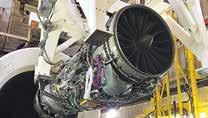
l First full engine successfully running since June with next-generation turbine blade technology
l Demonstrating advanced cooling technology to enable improved fuel efficiency
INNOVATION EVERYWHERE
Overall, CFM has already been able to reduce the complexity, weight and noise level of the RISE engine while maintaining significant performance benefits. In particular, the open fan design is now simpler and lighter. Stationary outlet guide vanes will replace previous two-stage, counter-rotating fan blades in the new architecture. This innovative change is crucial because it permits flight at speeds comparable to conventional turbofan engines.
With single-aisle planes constituting almost 70 per cent of the world’s rapidly growing commercial aviation fleet, the need to develop more efficient engines to power these aircraft is growing. For once, it is not fuel prices that are driving innovation. Rather, it is the need to reduce CO2 emissions to achieve a more sustainable aviation industry.
Once RISE emerges as a finished commercial product, the existing airframes will not serve. That is why CFM is maintaining close liaison with Airbus and Boeing seeking to convince them that RISE will definitely emerge as an amazing engine that will deliver a fuelburn reduction of over 20 per cent. Otherwise neither company is likely to gamble on risky new technology. In fact, Boeing, may be more inclined to pursue its Transonic Truss-Based Wing (TTBW) –a long and highly flexible slender wing, braced by trusses that also generate lift. Together with greater use of composite materials and other cutting-edge technologies Boeing believes the TTBW could deliver over 20 per cent fuel efficiency gains.
However, according to Mohamed Ali, Vice President of engineering for GE Aerospace, the 20 per cent efficiency goal “is practically impossible… without the open fan”. His irrefutable logic is that a current turbofan could be 20 per cent more efficient only if its core burned at “half the temperature of the sun’s surface.” “There is no material on earth that can sustain that,” he sums up.
Three years into the programme, it is clear that various RISE technologies are steadily evolving from promising design concepts to functioning components and systems. And the pace of progress is accelerating. According to Arjan Hegeman, general manager of Advanced Technology at GE Aerospace, “It’s full speed ahead for the RISE programme in 2024.” SP
14 ISSUE 6 • 2024 www.sps-aviation.com ENGINES TECHNOLOGY
Source: CFM; *image courtesy of Airbus
Fan Testing and Forgings
Aircraft Installation/ Integration Compact Core Turbine Blades
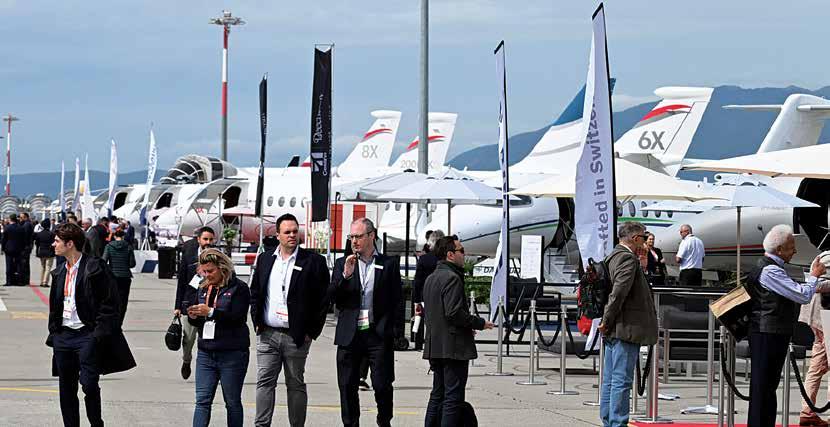
EBACE2024 EMPHASISED THE INDUSTRY’S COMMITMENT TO SUSTAINABILITY AND INNOVATION WITH KEY HIGHLIGHTS SUCH AS ACHIEVING NET-ZERO CARBON EMISSIONS BY 2050
A SHOWCASE OF THE LATEST TECHNOLOGICAL ADVANCEMENTS IN BIZAV
With the focus on sustainability and innovation, and a display of cutting-edge technological advancements, insightful discussions, and strategic collaborations, EBACE2024 provided a comprehensive glimpse into the future of aviation.
By AYUSHEE CHAUDHARY
One of the largest gatherings for the business aviation industry in Europe concluded after a grand celebration of the industry’s advancements. Co-hosted by the European Business Aviation Association (EBAA) and the National Business Aviation Association (NBAA), the European Business Aviation Convention & Exhibition (EBACE) 2024 yet again highlighted
groundbreaking trends and technologies in air travel. Held from May 28-30 in Geneva, the event featured the debut of new aircraft and industry innovations, alongside a Sustainability Summit. Attendees experienced the latest in bizjets, turboprops, rotorcraft, and advanced air mobility (AAM) vehicles, including electric- and hydrogen-powered, zero-emission
15 ISSUE 6 • 2024 www.sps-aviation.com SHOW REPORT EBACE2024
PHOTOGRAPH: EBACE

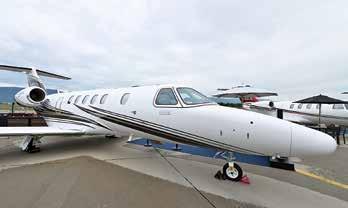
FEATURED SIGNIFICANT AIRCRAFT DISPLAYS, INCLUDING
PREATOR
10X
aircraft, alongside some promising announcements, deals, and launches.
EBACE2024 also offered an insight into the industry through the various discussions that took place on and off the stage. Key data analysts expressed confidence in industry growth for the second half of 2024, despite challenges with supply chains and workforce shortages as many presented an outlook of the industry. Global business aviation flights rose 1.2 per cent year-over-year from January to April 2024, though overall traffic dipped 1.5 per cent, according to WingX. Business aviation fleets showed strong growth, with single-tail operators experiencing an 18.1 per cent year-over-year increase. They also highlighted a unique global trend that witnessed European fleet growth outpacing the region’s GDP growth.
Post-pandemic supply chain issues have impacted production and services in 2024, but pressures are easing. A JetNet iQ survey of 439 owners and operators identified supply chain recovery and talent retention as significant challenges. Global Jet Capital (GJC) forecasted the business jet market will reach $193 billion in transactions between 2024 and 2028, with new deliveries projected to grow by 9.4 per cent this year and an average annual rate of 3.2 per cent over the next five years.
The event also noted the shortage of pilots in the industry, along with a lack of maintenance technicians, and other roles, with a 2023 CAE study projecting the need for 1,06,000 new business aviation professionals by 2032. The convention allowed a space for young professionals to interact and engage with experts from the industry and hear them during significant discussions that were centered on attracting young talent
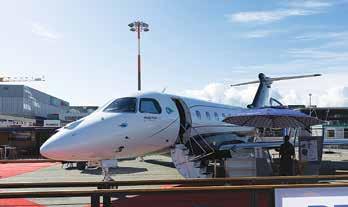

through outreach, internships, mentoring, and access to industry events. Despite challenges, the outlook for business aviation remains optimistic, with expected growth in charter flight demand and fleet expansion.
DISPLAYING AVIATION EXCELLENCE
Although key players like Gulfstream and Bombardier chose not to exhibit this year, the event still featured other major players, numerous exciting debuts, including VoltAero’s first eVTOL vehicle and various hydrogen and electric innovations. Bombardier chose to skip EBACE2024 to concentrate on regional marketing strategies but emphasised its ongoing support for EBAA and NBAA initiatives. Similarly, Gulfstream decided not to participate, aligning this choice with its business objectives.
The 2024 European Business Aviation Convention & Exhibition elevated its aircraft display to new heights, featuring the newly certified Gulfstream G700, striking business jets from Airbus, Boeing, and Dassault, and an impressive array of Textron airplanes. Dassault Falcon soared at EBACE taking center stage and showcasing its cutting-edge Falcon business jets to experience unparalleled comfort and performance. The recently launched Falcon 6X with its extra-wide cabin, alongside the ultra-long range Falcon 8X and popular 2000LXS were on display. Also offered was a sneak peek at the updated Falcon 10X mockup besides the service solutions with Dassault’s award-winning customer support team.
• Pilatus Aircraft debuted the upgraded PC-24 with a 600-pound payload increase, extended range, and new side-facing divan convertible to a bed. Pilatus also showcased the PC-12NGX turboprop.
16 ISSUE 6 • 2024 www.sps-aviation.com SHOW REPORT EBACE2024
EBACE2024
(CLOCKWISE FROM TOP LEFT) THE NEWLY CERTIFIED GULFSTREAM G700,
600 BY EMBRAER, DASSAULT’S FALCON 6X AND
MOCKUP, AND RANGE OF AIRCRAFT FROM TEXTRON AVIATION.
PHOTOGRAPHS: EBACE, EMBRAER / X

TALLER WIDER QUIETER BRIGHTER
The incomparable Falcon 6X cabin 1.98 m tall, 2.58 m wide. With wide aisles. Bright, extra-large windows and skylight. Whisper-quiet cabin. Cutting-edge technology. Amazing.
WWW.DASSAULTFALCON.COM I FRANCE +33 689 534 519 I INDIA: +91 99 6777 7347


(LEFT) LILIUM EVTOL AIRCRAFT IS TARGETING A 2026 MARKET ENTRY; (RIGHT) VÆRIDION IS ACCELERATING THE GREEN TRANSFORMATION OF AVIATION WITH A SMALL ELECTRIC AIRCRAFT THAT WILL BE CERTIFIED AND DELIVERED BEFORE 2030.
• Tecnam presented the P2012 STOL piston twin, approved for steep approaches and designed for short takeoff and landing operations. Tecnam’s P2012 STOL is the only twinpiston aircraft with such capabilities that complies with the latest certification amendments.
• Airbus Corporate Jets and Comlux displayed an ACJ TwoTwenty, emphasising its spacious cabin and intercontinental range, along with the ACH175 helicopter in a 12-passenger configuration.
• The first of five ACH160s for Air Corporate, which announced an order for 43 Airbus helicopters at the 2023 edition of the show, was also on display at EBACE2024.
• Dassault Aviation flew the Falcon 8X from Paris to Geneva, showcasing advanced technology, and presented a full-scale mockup of the 10X set for 2027.
• Leonardo unveiled a full-scale cabin mockup of the AW09 single-engine helicopter, marking its official entry into the Agusta family.
• Lufthansa Technik (LHT) showcased updates to its Networked Integrated Cabin Equipment (Nice) inflight entertainment (IFE) and cabin management platform, new aeromedical cabin systems, an innovative antenna radome, and a chemical-free fuel tank sanitisation method.
• Embraer highlighted the Praetor 600 and Phenom 300E, underscoring their suitability for European operators.
• VoltAero displayed a mockup of its hybrid-electric Cassio aircraft and demonstrated its technology with biofuel-powered flights. The company also flew its technology demonstrator aircraft to the event in Geneva from its headquarters in western France, running the propulsion system on biofuels made from wine.
• Lilium unveiled a full-scale model of the eVTOL aircraft targeting a 2026 market entry, aiming to connect communities across the French Riviera.
• Qatar Executive (QE) showcased a brand-new Gulfstream G700, soon to enter commercial service with a fleet of 10 by 2025.
• Alliance Aviation Group presented a newly painted Bombardier Global 6000.
• Textron Aviation displayed the Cessna Citation Longitude, Citation Latitude, Citation CJ4 Gen2, M2 Gen2, and the Beechcraft King Air 360.
EBACE2024 highlighted groundbreaking advancements and a collective vision for a sustainable future, with each display contributing to the vibrant mosaic of business aviation’s next chapter.
ALLIANCES AND ANNOUNCEMENTS
When industry leaders converge in a hub brimming with technological advancements, key discussions, and captivating displays, the event is bound to be more than just talks and sights. Collaborations, launches, deals, celebrations, and announcements are inevitable. Here are some of the major highlights from EBACE2024:
• Viasat underscored its dedication to improving connectivity solutions and fostering partnerships within the business aviation sector. The company celebrated the approval of Satcom Direct’s Plane Simple Ka-band tail mount terminal for the Gulfstream G650, a significant milestone in the rollout of SD’s antenna series.
• Axis Aviation introduced its asset management platform designed to simplify tasks and provide accessible, transparent information.
• Celebrating its 40th anniversary and making its EBACE debut last year, UK-based trip support provider General Aviation Services (G.A.S.) that offers permits, ground-handling solutions, and cost-effective fuel options across Africa and globally, expanded its operations to Botswana, Namibia, and Mozambique.
• Aria Hotels, a subsidiary of Libra Group, announced plans to construct and operate four vertiports across Greece worth €50 million of investment.
• Leonardo expanded its order book for the AW09 light helicopter through a distributorship agreement with Universal Vulkaan Aviation in India, adding five orders, and recent partnerships with Léman Aviation and Sloane, totaling 19 orders. Overall, AW09 orders have surpassed 100.
• Geneva-based Titan Aviation Fuels International expanded its European SAF distribution network with five new locations in Spain.
• Austria-based online aircraft charter facilitator VOO signed an agreement with European charter operator GlobeAir to offer exclusive instant booking capabilities for the GlobeAir fleet.
• Airbus Corporate Helicopters handed over the first ACH160 featuring the Lounge configuration of its Line cabin during a ceremony at EBACE2024.
• Lilium announced a partnership with Aéroports de la Côte d’Azur and Italian infrastructure group UrbanV to develop vertiports at multiple locations, starting with Nice Côte d’Azur Airport, Cannes Mandelieu Airport, and Golfe de Saint-Tropez Airport.
• German air service provider Flyvbird partnered with travel
18 ISSUE 6 • 2024 www.sps-aviation.com SHOW REPORT EBACE2024
PHOTOGRAPHS: EBACE

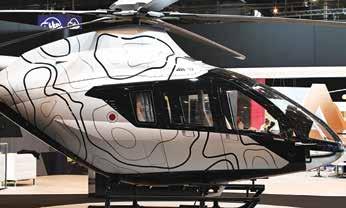
(LEFT) AIRBUS CORPORATE HELICOPTER ON DISPLAY; (RIGHT) LEONARDO UNVEILED A FULL-SCALE CABIN MOCKUP OF THE AW09 SINGLE-ENGINE LIGHT HELICOPTER.
planning company Moove to integrate Moove’s technology for faster, more sustainable air travel solutions.
• Textron Aviation announced enhancements to Garmin’s G5000 avionics for the Cessna Citation Latitude and Longitude, including the GDL 60 datalink for remote database downloading, a synthetic vision guidance system, 3D SafeTaxi, taxi routing, and a runway occupancy awareness function.
• Aviation solutions provider UAS International Trip Support and aviation sustainability leader 4AIR announced a strategic partnership to offer sustainable aviation solutions to UAS’s global clientele.
EBACE2024 has once again solidified its position as a premier event in the business aviation calendar, highlighting the industry’s unwavering commitment to sustainability and
innovation. This year’s convention was a hub of cutting-edge technological advancements, insightful discussions, and strategic collaborations. From showcasing revolutionary low-emission aircraft to unveiling sophisticated connectivity solutions, EBACE2024 provided a comprehensive glimpse into the future of aviation. The event also served as a platform for fostering the next generation of aviation professionals, ensuring that the industry continues to evolve in a responsible and forwardthinking manner. The resounding theme of sustainability and innovation rang clear. The event not only celebrated significant strides in green technology and advanced air mobility but also emphasised the importance of collaboration and strategic partnerships in driving the industry forward. With major deals and groundbreaking announcements, EBACE2024 has set a high tone for the future of the business aviation industry. SP
ADVANCED AVIATION MOBILITY
Ayushee Chaudhary
This year’s EBACE was a milestone, prominently featuring leading AAM companies at both the Palexpo exhibit hall and Geneva Airport, showcasing innovative low-emission and zero-emission aircraft powered by hydrogen, electric, and hybrid-electric systems. Experts discussed the future of automated commercial flights within the AAM sector, emphasising the need for a collaborative approach to safely integrate autonomous passenger aircraft into global airspace, starting with highly automated systems assisting pilots. EBACE2024 introduced an expanded Innovation Zone, highlighting key speakers from prominent eVTOL aircraft developers and other AAM stakeholders. Conference sessions covered topics such as hybrid hydrogen-electric eVTOLs, eVTOLs in emergency missions, and hydrogen propulsion for net-zero carbon goals.
Developers aim to enable fully automated commercial flights, with AI promising to revolutionise aviation. Experts noted that integrating automation with human pilots could enhance operations, but full autonomy will take time and require collaboration across the aviation ecosystem.
At the Innovation Pavilion, pioneering AAM companies showcased groundbreaking models, including Beyond Aero’s hydrogen-powered ONE, France’s first manned hydrogen-electric flight and future electric business jet; ELECTRON’s 100 per cent
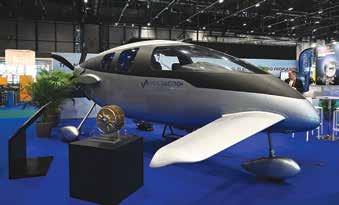
A MOCKUP OF VOLTAERO’S CASSIO 330 HYBRID-ELECTRIC AIRCRAFT
battery-powered regional aircraft and all-electric cargo plane; Hydroplane Limited’s modular hydrogen fuel cell for various aircraft types; Lilium’s all-electric eVTOL Jet set for a 2026 market release; Vaeridion’s efficient electric “microliners” expected to operate before 2030; and VoltAero’s hybrid-electric aircraft for diverse uses, with the Cassio 330 hybrid electric aircraft on display and its first flight anticipated by year-end. SP
19 ISSUE 6 • 2024 www.sps-aviation.com SHOW REPORT EBACE2024
PHOTOGRAPHS: EBACE
SUSTAINABILITY COMMITMENTS
EBACE2024 underscored the industry’s commitment to net-zero emissions with a three-day Sustainability Summit, a focus on alternative propulsion technologies, and the introduction of new sustainability standards. Highlights included Bertrand Piccard’s green hydrogen-powered global flight project, the first outdoor display of AAM aircraft, and an innovation pavilion showcasing next-generation planes. Discussions identified Sustainable Aviation Fuel (SAF) and the book-and-claim system as critical for reducing lifecycle greenhouse gas emissions by up to 80 per cent. Jet Aviation provided a 35 per cent SAF blend at Geneva Airport, marking its third year of SAF provision for EBACE. Business jet CEOs emphasised strategies like increased SAF production, low-emission propulsion, and industry collaboration to achieve net-zero emissions by 2050. Boeing Business Jets announced its leadership in NASA’s sustainable flight demonstrator project. The EU’s ReFuelEU Aviation Initiative mandates SAF use, starting with a 2 per cent share at EU airports by 2025. An Exhibitor Sustainability Pledge also promoted meaningful steps toward a greener event, with exhibitors committing to actions like carbon offsets and the use of recycled materials.
The launch of the Standards & Training for Aviation Responsibility and Sustainability (S.T.A.R.S.) programme underscored the commitment to sustainability and positioning business aviation at the forefront of achieving net-zero emissions by 2050. It involves a tiered
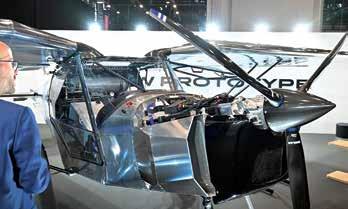
approach to policy development and implementation, focusing on greenhouse gas emissions, waste management, inclusiveness, and data privacy. At EBACE2024, EBAA also joined the CLIMBING.FAST. campaign, aiming for net-zero carbon emissions by 2050. Jet Aviation and Signature Aviation distributed SAF, achieving significant carbon savings. SP
PILATUS AIRCRAFT’S AVIATION UPGRADE
Pilatus Aircraft made a significant impact at this year’s EBACE by showcasing the newly upgraded PC-24 and the renowned PC-12 NGX. The debut of the enhanced PC-24, unveiled just before the NBAA-BACE in October, attracted considerable attention with its impressive upgrades. The PC-24 now boasts a 600-pound increase in payload, extending its range to 2,040 nautical miles, and features a new side-facing divan convertible into a bed. These enhancements were achieved through refinements in the wing and fuselage structures, reducing the empty weight by 660 pounds and optimising storage space, thereby increasing the maximum gross takeoff weight limit. The upgrades offer operators more flexibility, enabling longer flights and better accommodation for six passengers with luggage. Pilatus began delivering the upgraded PC-24 earlier this year and showcased it at the Aero Friedrichshafen general aviation show in Germany.
Most of the upgrades have received certification, with the divan approved for two seats and work for three seats ongoing. The divan option has exceeded the company’s expectations in popularity.
The PC-24 is used by fleets such as the Royal Flying Doctor Service in Australia and in Alaska’s North Slope Borough above the Arctic Circle. It features a maximum passenger capacity of 11+1 pilot, a maximum payload of 3,100 pounds, and can reach altitudes of up to 45,000 feet. The PC-24’s Advanced Cockpit Environment (ACE) offers high-tech simplicity with four 12-inch screens, an Inertial Reference System (IRS), Synthetic Vision System, Autothrottle, Graphical Flight Planning, TCAS II, and LPV guidance capability. The PC-24’s superior runway performance enables operation from airstrips that other jets can only fly over, earning it the title of a Super Versatile Jet.
Accompanying the PC-24 at EBACE was the PC-12 NGX turboprop, known for its 74 per cent lower emissions and full approval
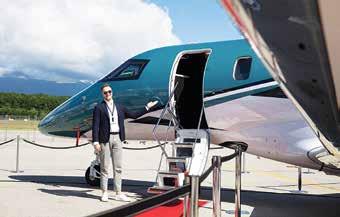
for SAF. The PC-12 NGX offers advanced avionics tailored for single-pilot operation, featuring an optimised autopilot, SmartView synthetic vision with HUD symbology, and an ACE cockpit environment. This model includes new technologies like tactile feedback in unusual attitudes, Emergency Descent Mode (EDM), and a Crew Alerting System (CAS) that automatically displays the relevant electronic checklist. The PC-12 NGX is virtually unrivaled in special mission capability, performing assignments like surveillance, medical assistance, cargo transport, and search and rescue with exceptional reliability.
Pilatus Aircraft thus showcased its committed efforts in aviation innovation and sustainability, at EBACE2024. SP
20 ISSUE 6 • 2024 www.sps-aviation.com SHOW REPORT EBACE2024
BEYOND AERO’S PROTOTYPE OF AN ELECTRIC AIRCRAFT POWERED BY HYDROGEN
PHOTOGRAPHS: EBACE, PILATUSAIRCRAFT / X
PILATUS DEBUTED THE UPGRADED PC-24 WITH AN EXTENDED RANGE
EMBRAER SHOWCASES ITS ENHANCED EFFICIENCY
Embraer highlighted its supermidsize Praetor 600 and light jet Phenom 300E at EBACE2024, focusing on their appeal to European operators. The Phenom 300E, a long-standing leader in its category for 12 consecutive years, also earned the distinction of being the most-flown business jet in the US last year, accumulating over 3,60,000 flight hours. Positioned as a versatile choice for European routes like London to New York and London to Dubai, the Praetor 600 boasts a nine-hour range and stands out for its technological advancements, making it a preferred option among operators familiar with larger aircraft. The Phenom 300E, known for its speed, quiet cabin, and advanced safety features such as the industry’s first runway overrun awareness and alerting system, continues to attract pilots seeking superior performance and comfort in business aviation.
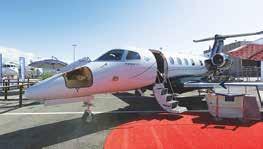
and customers operating larger planes due to its advanced features. Described by Embraer as a pilot’s dream, the Phenom 300E achieves speeds up to Mach 0.80, boasts a quieter cabin, best-in-class cabin altitude, and now includes autothrottle for enhanced flying precision. Its groundbreaking runway overrun awareness and alerting system, unique in business aviation, provides timely alerts to crews, mitigating risks during landing. Equipped for single-pilot operation, the Phenom 300E boasts to remain the sole aircraft in its category with a runway overrun awareness and alerting system.
Embraer underscored the Praetor 600’s suitability for the European market at the exhibition, highlighting its technological leadership in the super-midsize class. This aircraft is highly regarded among companies
While Embraer positions the Praetor 600 as the world’s most disruptive and technologically advanced super-midsize business jet, delivering superior cabin comfort with best-in-class altitude and HEPA filtration. Known for consistently completing London to New York flights, it offers unmatched performance and versatility in challenging airport environments. The Praetor 600 represents the pinnacle of performance, comfort, and technology, redefining the business jet experience. SP
TEXTRON AVIATION SHOWCASES PREMIER PRODUCTS AND SUPPORT
Textron Aviation made a strong presence at EBACE2024, highlighting its industry-leading aircraft and comprehensive aftermarket support. As a leader in the aviation industry, Textron boasts over 1,700 Cessna and Beechcraft turbine aircraft based in Europe and more than 2,50,000 aircraft delivered worldwide.
At the static display in Geneva, Textron featured five of its standout aircraft:
l Cessna Citation Longitude: With a four-passenger range of 3,500 nautical miles and best-in-class maintenance intervals of 800 hours or 18 months, the Citation Longitude offers 60 per cent less scheduled maintenance compared to its competitors. Equipped with the high-processing power Garmin G5000, optional HUD, and EVS interfaces, it provides advanced cockpit technology. The aircraft features spacious cabin legroom and is powered by two Honeywell HTF7700L turbofan engines, delivering low-cost maintenance and direct operating costs of $2,455 per hour.
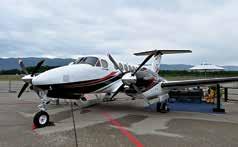
management system. It retains the proven performance of its predecessor with a range of 2,165 nautical miles and a maximum cruise speed of 451 KTAS. The M2 Gen2, ideal for corporate or private use, includes advanced cabin lighting, the latest Garmin G3000 flight deck, and a range of 1,550 nautical miles with a maximum cruise speed of 404 KTAS.
l Beechcraft King Air 360: This iconic turboprop offers a maximum range of 1,806 nautical miles, a cruise speed of 312 KTAS, and a capacity for 11 occupants. The King Air 360 features a luxurious cabin with improved comfort, contemporary design elements, advanced avionics, and an Onboard Maintenance System for enhanced troubleshooting.
l Cessna Citation Latitude: Renowned as the best-selling midsize business jet for eight years, the Citation Latitude offers a 6-foot stand-up cabin and a range of 2,700 nautical miles. It features NextGen-capable Garmin G5000 avionics and provides maximum comfort and productivity.
l Cessna Citation CJ4 Gen2 and M2 Gen2: The CJ4 Gen2 jet, designed for enhanced travel experiences, includes features like CoolView skylights, comfortable seating, and a wireless cabin
In addition to showcasing its aircraft, Textron Aviation emphasised its commitment to sustainability. The company renewed its pledge to sustainable practices by signing the EBACE Green Pledge, using local customer aircraft for exhibitions, flying all company-owned turbine aircraft on sustainable aviation fuel (SAF) for trade shows, and operating its demonstration fleet under the new ProAdvantage programme, SustainableAdvantage, to offset carbon dioxide emissions.
Textron’s Beechcraft and Cessna brands are celebrated for their global service network, and the company highlighted its extensive range of aftermarket products, services, and modifications at the event, reaffirming its position as a leader in aviation excellence and innovation. SP
— Ayushee Chaudhary
21 ISSUE 6 • 2024 www.sps-aviation.com SHOW REPORT EBACE2024
PHENOM 300E WAS THE MOST-FLOWN BUSINESS JET IN THE US LAST YEAR
PHOTOGRAPHS: EBACE
BEECHCRAFT KING AIR 360 AIRCRAFT ON DISPLAY
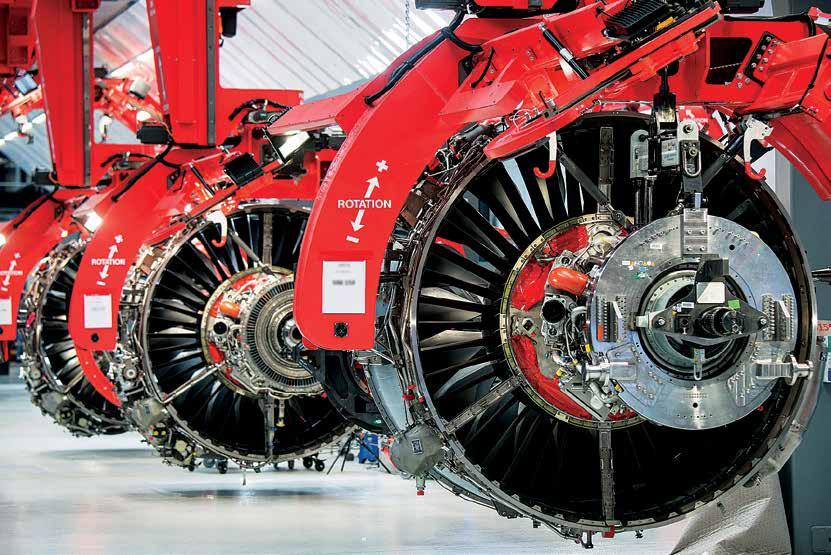
COMPARED TO ITS PREDECESSOR, THE LEAP ENGINE OFFERS A 15 PER CENT TO 20 PER CENT IMPROVEMENT IN FUEL EFFICIENCY AND BOASTS BEST-IN-CLASS DEPARTURE RELIABILITY RATES.
50 MILLION LEAP
The CFM LEAP engine family achieves 50 million flight hours, setting new standards in fuel efficiency, reliability, and sustainability in global aviation
By AYUSHEE CHAUDHARY
The CFM LEAP engine family celebrated a significant milestone in April this year, achieving 50 million flight hours across more than 3,000 aircraft operated by over 150 airlines globally. Since its entry into service in 2016, the LEAP engine, designed for the Airbus A320neo, Boeing 737 MAX, and COMAC C919 passenger jets, has consistently delivered on its promises of enhanced fuel efficiency, reduced noise, and lower CO2 emissions. This has enabled operators to achieve higher aircraft utilisation rates. Compared to its predecessor, the CFM56 engine, the LEAP engine offers a 15 per cent to 20 per cent improvement in fuel efficiency and boasts best-in-class departure reliability rates.
22 ISSUE 6 • 2024 www.sps-aviation.com ENGINES CFM
PHOTOGRAPH: CFM_ENGINES / X
Produced by CFM International, a joint venture between GE Aerospace and Safran Aircraft Engines, the LEAP engine’s impressive double-digit fuel efficiency gains allow aircraft to fly farther on a single tank of fuel while significantly reducing carbon and nitrogen oxide emissions. The advanced LEAP engine family sets new industry standards for fuel efficiency and asset utilisation, providing substantial improvements in fuel consumption, CO2 emissions, and noise levels.
Since its introduction, the LEAP engine has enabled operators to save more than 15 million tonnes of CO2. The LEAP-1A, LEAP-1B, and LEAP-1C models have all been jointly certified by the European Union Aviation Safety Agency (EASA) and the Federal Aviation Administration (FAA). The LEAP engine family is considered CFM’s most sustainable, with fuel usage 66 per cent lower than driving the same distance and up to a 20 per cent improvement in fuel and CO2 emissions.
The LEAP engine is renowned for its rigorous testing, relentless focus on reliability, and use of revolutionary materials. These
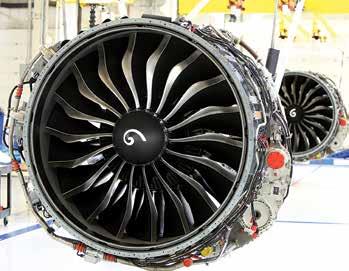
include additively manufactured (3D-printed) parts such as fuel nozzle tips, turbine shrouds made of ceramic matrix composites (CMCs), and 3D-woven carbon-fiber composites in the fan blades and case. The engine’s second-generation twin-annular, Premixing Swirler Combustor (TAPS II) reduces NOx emissions by 50 per cent compared to CAEP/6 standards. Unlike traditional combustors that mix fuel and air inside the combustion chamber, the LEAP nozzle pre-mixes these elements to achieve lean burn combustion. Additionally, the LEAP debris rejection system provides superior erosion protection, preventing sand, dirt, and other harmful particles from reaching the engine core, resulting in a highly durable and efficient engine that remains newer for longer.
THE CFM LEAP’S HIGHLIGHTS
Since its revenue service launch in August 2016, the LEAP engine has seen widespread adoption, with more than 4,000 engines in service across six continents as of June 2022 and 9,700 engines on order. This robust adoption highlights the LEAP engine’s significant contributions to advancing aviation sustainability and efficiency.
Enhancing Engine Health Monitoring with Machine Learning. Recently, as the LEAP engine fleet approached the 50 million flight hour milestone, CFM International expanded its engine health monitoring capabilities with machine learning to provide operators with more accurate insights than ever before.
David Harper, Fleet Support Director for GE Aerospace, further emphasised the benefits, “Combining this health monitoring system with our global CFM fleet support team has resulted in a 60 per cent earlier lead time in identifying preventative maintenance recommendations, a 45 per cent increase in detection rates, and a 50 per cent reduction in false alerts over the past decade.”
The advanced system models data from multiple engine sensors during takeoff, climb, and cruise, using probabilistic diagnostic and prognostic tools to generate targeted alerts based on known engine operating signatures. This sophisticated approach has led to earlier detection of potential issues, significantly improving operational reliability.

Agathe Venard, Head of Fleet Data Engineering, highlighted the impact of these advancements, “These state-of-the-art analytics provide LEAP operators with the data they need to make informed, insightful decisions about fleet management, ensuring a level of fleet stability that is crucial for day-to-day operations.”
The LEAP Promise. CFM International initially promised significant improvements in fuel efficiency, noise reduction, and CO2 emissions with the LEAP engine. “Eight years into service, CFM appears to have underpromised and overdelivered,” the manufacturer marks. The company states that not only has the LEAP engine maintained a 15 per cent to 20 per cent improvement in fuel efficiency over its immediate predecessor (the CFM56 engine) but it has racked up a 99.95 per cent departure reliability rate. To date, nearly 8,000 LEAP engines have been delivered, with over 10,000 engines on order.
Meeting Maintenance Demands. To support the extensive LEAP engine fleet, CFM has developed an open Maintenance, Repair, and Overhaul (MRO) ecosystem. This approach fosters market competition, incentivising MRO providers to invest in their facilities, which leads to competitive pricing and improved
23 ISSUE 6 • 2024 www.sps-aviation.com ENGINES CFM
PHOTOGRAPHS: CFM, CFM_ENGINES / X
(LEFT) NEW LEAP-1B ENGINES BEING PREPARED FOR THE BOEING 737 MAX; (RIGHT) CFM LEAP-1A-POWERED A321XLR.
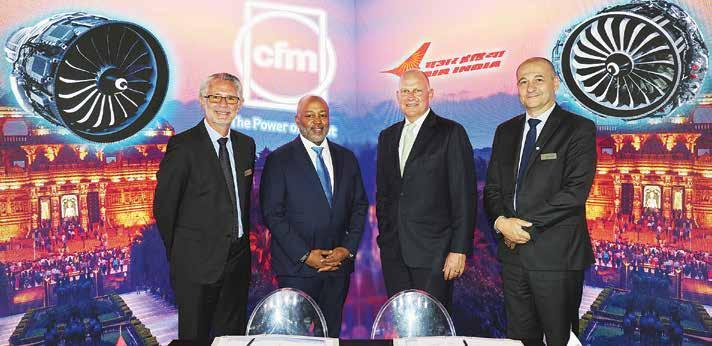
turnaround times. This ecosystem offers LEAP customers a variety of maintenance options, from standard line maintenance to full-performance restoration shop visits (PRSVs).
CFM’s internal network includes eight shops operated by GE Aerospace and Safran Aircraft Engines, along with 10 on-site support bases worldwide, providing quick turn maintenance solutions. “The LEAP engine design is stable, and we’ve significantly reduced the maintenance burden since its entry into service,” said Karl Sheldon, LEAP programme General Manager at GE Aerospace.
Innovations and Support. CFM continues to innovate with the introduction of an improved high-pressure turbine (HPT) blade design in 2024, aimed at minimising early engine removals, particularly in hot and harsh environments. Additionally, CFM has recently introduced a reverse bleed system (RBS) for the LEAP1A engines, designed to reduce on-wing fuel nozzle replacements due to carbon deposit buildup. This system circulates cooling air through the engine core, preventing carbon deposits and reducing maintenance needs. “The RBS is a testament to our teams’ ingenuity, offering a solution that minimises maintenance burden and integrates seamlessly with existing aircraft systems,” said Gaël Méheust, President and CEO of CFM International.
Beyond its MRO ecosystem, CFM provides round-the-clock customer support with 250 field service engineers stationed globally and call centers in Paris, Shanghai, Bengaluru, and Cincinnati, ensuring comprehensive technical assistance for its customers.
LEAP ENGINES POWERING THE FUTURE OF INDIAN AVIATION
Indian airlines have also continued to rely on the CFM LEAP engines to power their fleets, marking a significant shift towards more efficient and sustainable aviation technologies.
• At the beginning of this year, Akasa Air and CFM International entered into a landmark agreement to purchase CFM LEAP-1B engines for 150 Boeing 737 MAX airplanes. This
partnership builds on Akasa Air’s 2021 announcement to utilise LEAP-1B engines for its Boeing 737 MAX fleet.
• Air India has also made a substantial commitment to CFM LEAP engines, finalising an order to power its new fleet of 210 Airbus A320/A321neos and 190 Boeing 737 MAX family aircraft. This significant order, first announced in February 2023, included 800 LEAP engines: 420 LEAP-1A and 380 LEAP-1B, along with spares. Additionally, Air India and CFM International had signed a multi-year services agreement covering the airline’s entire fleet of LEAP engines, ensuring long-term operational support and reliability.
• In 2021, IndiGo selected CFM International’s LEAP-1A engines for its extensive fleet of 310 new Airbus A320neo, A321neo, and A321XLR aircraft. This agreement not only secured the LEAP-1A engines but also included long-term service agreements for a total of 590 IndiGo A320neo family aircraft. The trend among Indian airlines to adopt CFM LEAP engines reflects a broader industry shift towards more efficient and environmentally friendly aviation solutions. With their advanced design and proven reliability, LEAP engines promise to enable airlines to achieve better fuel efficiency, reduced emissions, and higher aircraft utilisation rates. These partnerships are poised to transform the landscape of Indian aviation, setting new standards for operational excellence and sustainability. LEAP’s remarkable achievement underscores the engine’s pivotal role in advancing the aviation industry towards a more sustainable future. The CFM LEAP engine continues to redefine aviation standards with its groundbreaking performance, reliability, and sustainability. With a growing order book, the LEAP engine is poised to further its impact on the industry. As the CFM LEAP engine family continues to set new standards in aviation, its advancements in machine learning for health monitoring and ongoing innovations ensure that it remains at the forefront of the industry, providing reliable and efficient solutions for commercial aviation. SP
24 ISSUE 6 • 2024 www.sps-aviation.com ENGINES CFM
PHOTOGRAPH: CFM
AIR INDIA HAS PLACED AN ORDER FOR 800 LEAP ENGINES (420 LEAP-1A AND 380 LEAP-1B), ALONG WITH SPARES AND A MULTI-YEAR SERVICES AGREEMENT COVERING THE AIRLINE’S ENTIRE FLEET OF LEAP ENGINES
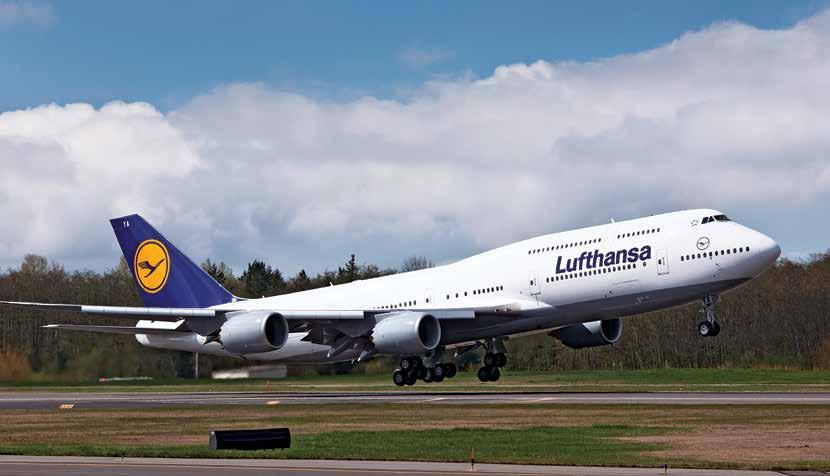
SLOW FADE OF THE FOUR-ENGINE AIRLINER
As long-haul international tourism recovers, some leading carriers have been returning their superjumbos to service. The A380 that seemed destined to fade into the sunset has received a new lease of life.
By JOSEPH NORONHA
Time was when a four-engine jet airliner was everybody’s idea of the perfect way to reach a dream destination on another continent. Well-heeled travellers loved the ample space and the lavish cocktail lounges and restaurants on the double-decker Boeing 747. First class Emirates passengers on the gigantic Airbus A380 – of which the Dubai-based carrier has the world’s largest fleet of 116 aircraft – could even enjoy an inflight shower.
In fact when the jet age began in 1952, it was with fourengines all the way. The de Havilland Comet, the world’s first jet passenger aircraft, may have been a safety nightmare. But the Boeing 707 that followed in 1958 proved that jetliners could be both safe and successful. All through the 1960s,
four-engine airliners or “quads”, such as the Douglas DC-8 and Boeing 707, dominated both the domestic and long-haul airspace because they were seen as safer than twinjets. In fact, United States (US) Federal Aviation Administration (FAA) regulations required twin-engine aircraft to have a diversion airport available within 60 minutes flying time throughout their route. This made them impractical for transoceanic journeys. In the 1960s and 1970s, three-engine planes or “trijets” became popular since they were more economical than quads and their operation was not as strictly limited as that of twinjets. The Boeing 727 trijet introduced in 1964 was highly successful and 1,832 were built.
25 ISSUE 6 • 2024 www.sps-aviation.com CIVIL AIRLINERS
PHOTOGRAPH: BOEING
THE BOEING 747, WITH ITS FOUR ENGINES, IS BEING PHASED OUT IN FAVOUR OF TWIN-ENGINE JETS THAT ARE CHEAPER TO OPERATE AND ALSO SIGNIFICANTLY REDUCE FUEL CONSUMPTION
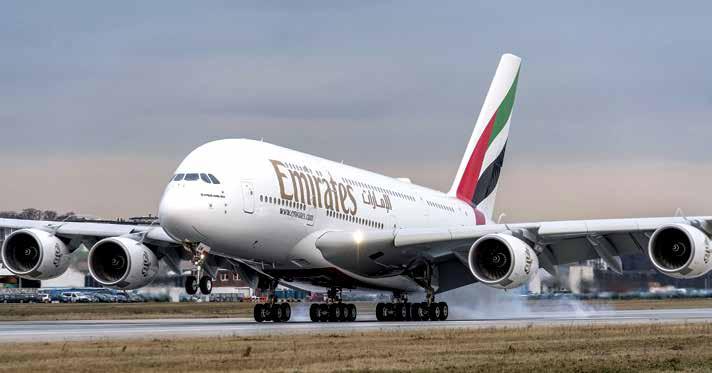
DUE TO HIGH FUEL COSTS, AIRBUS A380 BECAME TOO EXPENSIVE TO OPERATE AND MAINTAIN THAN NEWER, MORE FUEL-EFFICIENT AIRCRAFT
BOEING’S BIG BET
However, the real revolution in air travel came when Pan Am’s legendary founder Juan Trippe asked Boeing to build a much bigger airliner. When the Boeing 747 “jumbo jet” entered service in January 1970 it was a true game-changer. With its four high-powered turbofan engines and up to 480 all-economy seat capacity, the hump-backed “Queen of the Skies” transformed the economics and reach of passenger aviation. By gathering travellers from many smaller planes into one huge airliner, it helped relieve the congestion at major airports across the globe.
The Boeing 747’s market entry came even as longer routes were being steadily opened up – routes that only big four-engine planes could serve due to the 60-minutes stipulation. Dozens of airlines snapped up the 747, including Air India. Airbus tried to challenge Boeing’s dominance in the long-haul market; but its A380 “Gentle Green Giant” finally entered commercial service only in October 2007. By then, the slow fade of the four-engine fleet was beginning.
FALL FROM GRACE
Fast forward to today, both the Boeing 747 and the Airbus A380 are viewed as something of a liability by many carriers. Compared to the economical modern jets, the quads are fuel-guzzling machines, and inefficient to operate unless practically every seat is filled. Ask any airline executive what a nightmare it can be to find 853 all-economy passengers for a single A380 and you will realise why the Green Giant is not quite an object of desire any more. Seeing the writing on the wall, Boeing ended a prolonged 54-year production run of its 747 in December 2022, with 1,574 aircraft built. Airbus had already closed its A380 assembly line in December 2021 after a 15-year run of a paltry 254 planes. The company has taken a huge $25 billion hit from the programme. What accounts for the fall from grace of these two behemoths?
PRICE OF TWINJET EFFICIENCY
Strangely enough, the responsibility for the decline of the quads rests with Boeing and Airbus themselves. They focussed so much on building efficient twin-engine airliners, that could fly farther for cheaper, that a point came when everyone began to realise that anything four engines could do, two engines could do better. The trend began around 1995 with the introduction of the Boeing 777. This twinjet could carry more passengers than the Airbus A340, and nearly as many as the Boeing 747, but with far lower operating costs. Produced in eight variants so far, the Boeing 777 has already notched up 2,239 deliveries and orders, far outstripping the Boeing 747. The Boeing 777-9 that made its first flight on January 25, 2020, is the world’s longest and largest twin-engine airliner. It is claimed by Boeing to be the most efficient twinjet, “unmatched in every aspect of performance” and is expected to commence commercial service in 2025. The Boeing 787 Dreamliner is another ultra-efficient wide-body twinjet, recording 1,843 orders and deliveries since its introduction in 2011.
Yet another telling illustration comes from Airbus that started development on the A330 twinjet in parallel with the A340 quad, launching both designs in June 1987. The A330 has already recorded 1,810 orders and deliveries – a massive improvement over the A340’s total tally of just 377 – making the A330 the second most delivered wide-body airliner after the Boeing 777. Meanwhile, the A340 quad has itself evolved into the far more efficient A350 twinjet, built as a counter to Boeing’s Dreamliner, and A350 orders and deliveries now stand at 1,072 (all figures are as of November 2023).
REMARKABLE RANGE
In the 1980s, Extended-range Twin-engine Operations Performance Standards (ETOPS) were introduced that permitted
26 ISSUE 6 • 2024 www.sps-aviation.com CIVIL AIRLINERS
PHOTOGRAPH: AIRBUS
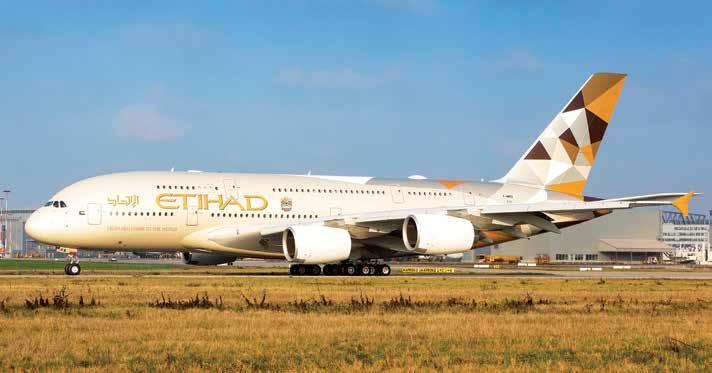
twin-engine aircraft operation beyond 60 minutes from a diversion airport at the one-engine inoperative cruise speed, depending on the type’s rating. At one stroke, this opened up the transoceanic space to twinjets, so long as they could meet the necessary technical requirements. The Boeing 767 was the first twinjet to be rated at 120 minutes ETOPS. The ETOPS rating of various airliners continued to increase, with the Airbus A350XWB now permitted 370 minutes. That means the plane can operate practically as the crow flies on any route in the world without altering course to stay close to a diversion. The twinjet Boeing 787 and the A350 now fly on most of world’s longest routes and are swiftly replacing quads as the flagships of choice of most fleets. The Singapore Airlines Airbus A350900ULR flight from New York to Singapore takes 18 hours 50 minutes to cover the 15,349 km distance, making it the world’s longest flight by distance.
Engine power has also increased tremendously. While the combined thrust of the four Pratt & Whitney JT3D turbojet engines on the Boeing 707 was only 68,000 pounds, a single General Electric GE9X turbofan on the Boeing 777X produces 1,05,000 pounds of thrust. This is what makes it possible for large wide-body airliners to have just two engines.
TWIST IN THE TALE
What then does the future hold for quads? In an age of rising fuel prices and growing concern over climate change, economy and efficiency are the watchwords. Four-engine airliners such as the Boeing 747 and the Airbus A380 were admirably suited to the hub-and-spoke system of airline operation. However, that system has been largely replaced by the point-to-point system, where travellers reach their destination in a single flight instead of two or three, saving both time and money in the bargain. It is unlikely that the hub-and-spoke model will
ever find favour again. From purchase price to cost of operation to maintenance, twin-engine aircraft are more economical than quads. Scheduling is also more flexible. Airlines can operate two 787 Dreamliner or A350 flights at different times of the day to suit differing passenger requirements for less than the cost of one Airbus A380 flight.
While quads are highly efficient for very long-range flights with most seats filled, they become uneconomical and major carbon emitters on short-to-medium haul flights. And they need special airport facilities. The COVID-19 pandemic and the consequent plunge in air traffic also accelerated the gradual fading away of the quad.
And yet, could there be a surprise ending to the story? As long-haul international tourism recovers, some leading carriers have been returning their superjumbos to service. The A380 that seemed destined to fade into the sunset has received a new lease of life. This is largely thanks to Emirates. Emirates continues to be the largest operator of the type and has no plans to withdraw the airliner from service for at least another twenty years. The carrier has started operating new A380 airliners with refreshed interiors and the latest luxury seats. Passengers can even check in to the spa during flight and pamper themselves with a set of luxury organic seaweed products. Last year, Emirates CEO Tim Clark also called for the development of a re-engined version of the A380 that could potentially slash fuel emissions by up to 25 per cent, creating a more economical airliner. Should Airbus bite the bait, it could keep the A380 flying for many more years.
Still, the gradual fading away of the quad is perhaps inevitable. No manufacturer has plans to design a new four-engine jet. No airline would wish to have more. A time may come when the Boeing 747 and the Airbus A380 will survive only as cargo or military transport aircraft. SP
27 ISSUE 6 • 2024 www.sps-aviation.com CIVIL AIRLINERS
PHOTOGRAPH: ETIHAD
IN COMPARISON TO FOUR-ENGINE PLANES, TWIN-ENGINE PLANES COULD SERVICE THE SAME ROUTES AND BE SEEN AS A MORE COST- AND ENVIRONMENTALLY-FRIENDLY CHOICE
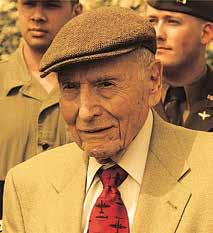
SI SPIEGEL (1924-2024)
Si Spiegel’s B-17 experienced engine trouble early in the bombing mission. Then, as he flew over Berlin, ground fire knocked out a second engine. He still had two engines running, but soon a fuel tank started leaking.
Si Spiegel was just one of tens of thousands of young Americans who were rushed to the European front during the Second World War. However a single bombing mission towards the fag end of his career marked him as one of the more noteworthy such pilots.
Si Spiegel was born on May 28, 1924, in Manhattan, New York. After graduating from high school, he was keen to fight the Nazis. So without telling his parents, he enlisted in the Army soon after he turned 18. Thanks to his mechanical skills he was sent to the aircraft mechanic school. He was terribly disappointed. However, a sympathetic officer told him about another recruitment office at Mitchel Field, not far distant. There he found that he was one of only two pilot applicants, and the other candidate was ineligible due to poor eyesight. Spiegel’s perfect vision and other qualities finally got him into pilot training.
Once his training was done, Spiegel was assigned to the 8th Air Force, based at Eye, England. Just 20 years old, he flew numerous bombing missions on the B-17 Flying Fortress for the next several months. Raids against Germany were often carried out in daylight and the massive B-17s were sitting ducks for the skilled German gunners. More than 50,000 American airmen were killed, with the 8th Air Force alone suffering 40 per cent of all casualties in the air campaign.
The Berlin Mission commenced on the morning of February 3, 1945. A massive force of 1,437 bombers and 948 fighters took off from England ostensibly against Nazi Germany’s Luftwaffe headquarters. However the sheer size of the airborne armada indicated that the Allied commanders were determined to hit the Germans where it hurt and if some bombs fell on civilians they would not be unduly concerned.
Si Spiegel’s B-17 experienced engine trouble early in the bombing mission. Then, as he flew over Berlin, ground fire knocked out a second engine. He still had two engines running, but soon a fuel tank started leaking. Assessing that he would not be able to make it back to England safely, Spiegel ordered his crew to prepare to crash-land. His main aim was to try and get across the Russian frontline. No Jewish pilot would want to get shot down and be captured by the Nazis, so he turned the giant stricken bomber towards Poland. Meanwhile, his radio operator made contact with England and relayed their status: “No one hurt, two engines out, attempting to land in Warsaw.”
Trying to identify a suitable landing spot, Spiegel headed downriver until he was able to carry out a belly landing on a frozen potato field. The crew were rescued by Russian troops and eventually brought to the Polish city of Toruń. Although the Americans were not prisoners they could not leave without approval from Moscow. Spiegel met another B-17 pilot named George Ruckman, whose plane had lost one engine to flak and had blown a tyre while force landing. Ruckman and Spiegel soon devised a wild escape plan. A team would go to Spiegel’s wrecked plane, 70 miles away, and collect an engine and a spare tyre to repair Ruckman’s bomber.
Employing a judicious mix of secrecy and courage, and liberally bribing the Soviet soldiers, they managed to retrieve an engine and spare tyre. Using tools left behind by the Nazis, the crews worked in plain sight of the Russians to repair the plane. Perhaps the Russians never imagined they would actually make the bomber flightworthy. But they did. On March 17, 1945, Ruckman and Spiegel managed to get the giant B-17 airborne and carefully nursed the tottering aircraft with 19 men on board towards the south till they landed safely at an American air base in Italy. Spiegel returned home to a hero’s welcome on August 31, 1945.
Post-war, many veteran pilots joined the commercial airline industry but Spiegel was told that Jews were not wanted. However, he managed to get a job as a machinist with a brush manufacturer in New York. When sales of brushes plunged, the company experimented with producing artificial Christmas trees. Spiegel convinced his bosses that the industry was set to explode in sales. He was allowed to start his own Christmas tree division called American Tree and Wreath. He studied real trees and soon mastered the art of making perfectly shaped Christmas trees. By the mid-1970s, the business really took off. Spiegel left the company in 1979 and two years later founded the Hudson Valley Tree Company, which began mass-producing 80,000 trees a year. Spiegel who was now known as “king of the artificial Christmas tree” patented his designs and launched his own line of artificial trees before retiring in 1993 as a multimillionaire. He died on January 21, 2024, four months short of his 100th birthday. SP
— JOSEPH NORONHA
HALL OF FAME 28 ISSUE 6 • 2024 www.sps-aviation.com
MIITARY
LOCKHEED MARTIN DELIVERS 2,700TH C-130 HERCULES TACTICAL AIRLIFTER
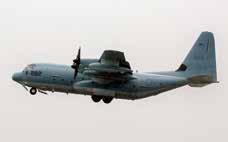
Lockheed Martin recently delivered the 2,700th Hercules multi-mission tactical airlifter, increasing the size, reach and strength of the worldwide C-130 fleet. This landmark aircraft is a KC-130J Super Hercules tanker operated by the US Marine Corps.
Defined by its proven performance and unmatched versatility, operators in 70 nations around the world fly C-130 airlifters to support any mission — anywhere, any time. The current C-130 production model is the C-130J Super Hercules, which includes the KC-130J tactical tanker. To date, the C-130J is certified to support 18 different mission requirements.
The KC-130J is the global standard for tactical tankers, refueling a majority of rotary wing aircraft in operation today and multiple fixed-wing aircraft including the Lockheed Martin F-35B/C Lightning II fighter aircraft. With its truly tactical design, the KC-130J has the ability to fly at the slow speeds and low altitudes that are ideal when refueling helicopters.
Always evolving, continually innovating and ready for what’s next, the Super Hercules leads the charge by setting standards and shaping the future of tactical airlift missions — including humanitarian operations around the world. The global C-130J fleet spans 26 operators in 22 nations with 20+ air worthiness certifications. With nearly 3 million flight hours logged across the global fleet of 540+ C-130Js, invaluable insights gained from missions in every scenario equip the C-130J for what’s next.
GA-ASI & USMC COMPLETE MQ-9A WTI TRAINING
General Atomics Aeronautical Systems, Inc. (GA-ASI) and the US Marine Corps (USMC) teamed up to conduct flight training on the operation of the MQ9A Block 5 Unmanned Aircraft System (UAS) for the Marine Aviation Weapons
INDIA’S NEW CIVIL AVIATION MINISTER
Kinjarapu Ram Mohan Naidu (born 18 December 1987) was announced as the Minister of Civil Aviation on June 10, 2024 in the newly formed Government of India, after the general elections in 2024. An Indian politician, he represents Srikakulam Lok Sabha constituency and won as the Member of Parliament in the 16th 17th, and 18th Lok Sabha from, Andhra Pradesh. He won the Indian general election, 2014, 2019 and 2024 as a Telugu Desam Party (TDP) candidate. He is also

the National General Secretary of the TDP and the Leader of the Party in the Lok Sabha.
Kinjarapu Ram Mohan Naidu did his primary schooling in Srikakulam and later on joined Delhi Public School, R. K. Puram, Delhi, to complete his school education. He then earned a bachelor’s degree in electrical engineering from Purdue University, United States and an MBA from Long Island University. He worked for a year in Singapore before returning to India. SP
APPOINTMENTS

AIR OFFICER COMMANDING-IN-CHIEF, MAINTENANCE COMMAND, IAF
Air Marshal Vijay Kumar Garg, assumed the appointment of Air Officer Commanding-in-Chief, Maintenance Command, Indian Air Force on June 1, 2024. He was commissioned in the Aeronautical Engineering (Mechanical) branch of Indian Air Force on August 19, 1986. Prior to assuming the present appointment, the Air Marshal was holding the appointment of Senior Maintenance Staff Officer at HQ MC.

ATR’S NEW CHIEF FINANCIAL OFFICER
The Board Members of ATR appointed Andrea Coccetti as the company’s new Senior Vice-President Finance and Chief Financial Officer, effective May 1, 2024. Andrea brings 20 years of experience having held key financial leadership positions at Leonardo. As the new CFO, Andrea will play a pivotal role in shaping ATR’s financial strategies and contributing to the manufacturer’s continuous innovation and development initiatives.

PRESIDENT OF IAE INTERNATIONAL AERO ENGINES
International Aero Engines AG (IAE) has named Kelly Horan as its President. As President, Horan will lead the integrated programme structure to support the IAE V2500 programme and to ensure financial, business, technical, customer and partner commitments are achieved. She brings more than 25 years of experience in engineering, supply chain and commercial aftermarket to this role.
and Tactics Squadron One (MAWTS-1). The students participated in Weapons and Tactics Instructor (WTI) Course 2-24, which is a comprehensive course designed for select pilots and enlisted aircrew that incorporates Marine Corps planning along with implementation of advanced air and ground tactics. The WTI course is renowned for its advanced graduate-level training, particularly in refining tactical skills and strategies for aviation operations. It is an inte-
29 ISSUE 6 • 2024 www.sps-aviation.com NEWS DIGEST
KINJARAPU RAM MOHAN NAIDU, CIVIL AVIATION MINISTER, INDIA
gral part of developing and implementing cutting-edge aviation weapons and tactics, both in terrestrial and maritime settings.
NORTHROP GRUMMAN’S AUTONOMOUS VTOL
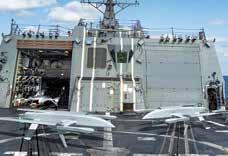
NGC has been selected by the Defense Advanced Research Projects Agency (DARPA) for the next design phase of its autonomous vertical takeoff and landing aircraft, as part of the AdvaNced airCraft Infrastructure-Less Launch And RecoverY (ANCILLARY) programme.
DARPA’s ANCILLARY Phase 1b air vehicle design and system technology maturation award will have a 10-month period of performance to increase modeling fidelity, perform critical subsystems testing, and reduce key technical risks.
NEW C-390 TRAINING CENTER IN EUROPE

Embraer and Rheinmetall are in discussions to expand their training network with a focus on the C-390. The aim is to evaluate the needs of the increasing number of C-390 European customers with respect to training and decide on the development of a dedicated training center in the region, supporting existing and future C-390 customers.
Currently, there is an Embraer C-390 Training Center in Brazil, in the state of São Paulo, featuring a Full Flight and Mission Simulator (FFMS) and a Loadmaster Training Station, where Brazilian, Portuguese, and Hungarian Air Forces C-390 crews are having their initial training. Embraer and Rheinmetall aim to analyse ways to increase proximity with their current and future C-390 customers, to ease the training
QATAR EXECUTIVE WELCOMES THE WORLD’S FIRST GULFSTREAM G700 AIRCRAFT TO DOHA
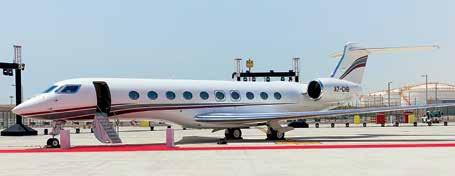
Qatar Executive (QE), the corporate jet subsidiary of Qatar Airways Group, has officially welcomed the delivery of two new Gulfstream G700 aircraft to the fleet, becoming the worldwide exclusive commercial operator of the aircraft. Qatar Executive is the first carrier to offer the Gulfstream G700 to charter customers, continuing to provide an ultra-modern fleet with the ultimate in aircraft capabilities, luxury and performance. The G700 represents the future of private air travel, offering a superior flying experience with unrivalled design,
technology, comfort and style. The aircraft offers an exceptionally spacious passenger cabin consisting of four individual living areas including a dedicated private rear stateroom with a permanent fixed bed. The bespoke cabins have been designed and meticulously crafted to meet the standards of Qatar Executive’s most discerning customers. The passenger experience has been augmented to include a revolutionary lighting system, the industry’s lowest cabin pressure altitude and natural lighting through 20 windows. SP
IBAC MARKS IS-BAH 10 YEAR ANNIVERSARY WITH SALUTE TO SRC AVIATION
The International Business Aviation Council (IBAC) announced the 10th anniversary of the International Standard for Business Aircraft Handling (IS-BAH) programme at EBACE 2024 and honoured SRC Aviation of New Delhi, India, as the first ground handling organisation to reach the 10-year IS-BAH milestone. To commemorate the founding anniversary, IS-BAH will introduce a campaign focusing on its objective: ‘Elevating Ground Handling Safety.’
Kurt Edwards, Director General for IBAC, said, “We are grateful for SRC Aviation and their proactive approach to safety. They became the first organisation to implement IS-BAH in 2014 with a successful Stage 1 audit and have continued their leadership in the programme. Today, we recognise Bobby Chadha and the entire SRC Aviation team for reaching ten years with IS-BAH and thank them for their support and dedication to safety.”

Bobby Chadha, Managing Director for SRC Aviation, commented, “We are very proud to have been the first IS-BAH recognised ground handler on the planet, and now achieving the 10-year mark makes it even more special. Implementing IS-BAH has significantly benefited us by reinforcing our commitment to ground handling safety and elevating our service quality.” SP
30 ISSUE 6 • 2024 www.sps-aviation.com NEWS DIGEST
for pilots, loadmasters, mechanics, and additional crew members.
RUDRAM-II SUCCESSFULLY FLIGHT-TESTED FROM SU-30 MKI OFF THE ODISHA COAST

Defence Research & Development Organisation (DRDO) successfully flight-tested the RudraM-II air-to-surface missile from Su-30 MKI platform of the Indian Air Force (IAF) on May 29, 2024. The flighttest met all the trial objectives, validating the propulsion system and control & guidance algorithm. The performance of the missile has been validated from the flight data captured by range tracking instruments like electro-optical systems, radar and telemetry stations.
RudraM-II is an indigenously-developed solid-propelled air-launched missile system meant for Air-to-Surface role to neutralise many types of enemy assets.
CIVIL
GLOBAL JET CAPITAL Q1 2024 MARKET BRIEF
In Q1 2024, the business jet market continued to normalise following the record high utilisation and demand associated with the post COVID-19 pandemic period. Flight operations and transactions slowed from all-time highs; however, flight operations remained well above pre-COVID-19 levels and transactions remained within the range of historical averages. Transactions declined in Q1 2024 due to slowerthan-expected new deliveries (attributable to ongoing supply chain and labor issues and delays in aircraft certification) and price-driven inertia between buyers and sellers in the pre-owned market.
Over the past few quarters, a shift has emerged with aircraft inventory and values. During the post-COVID expansion, older aircraft became very popular due to their wide availability. However, as the market has normalised, demand for these aircraft has declined. As a result, aircraft listings and inventory for aircraft older than 12 years have increased, while values for this segment have declined. At the same time, inventories and values for 12-year-old and younger aircraft have
remained largely stable. In addition to steadiness in the young pre-owned market, OEMs continue to report strong order intake and rising backlogs. As a result, the business jet market is in a strong position to remain resilient to any potential economic disruptions.
FLY91 SELECTS ATR’S PAY-BY-THE-HOUR SUPPORT PROGRAMME
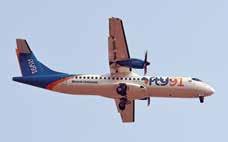
ATR and Indian regional airline FLY91 announced the signature of a Global Maintenance Agreement (GMA), a pivotal step towards providing reliable and cost-effective regional air travel across India. Under this comprehensive agreement, ATR will provide repair, overhaul and pooling services of Line Replaceable Units, propeller availability and repair services, as well as engineering and on-site support for FLY91’s growing fleet of ATR aircraft. Initially covering two ATR 72-600, the 100 per cent tailor-made pay-by-the-hour contract is set for a duration of five years, with a clear path from FLY91 to substantially increase its ATR fleet within the same timeframe, up to 30 aircraft.
P&W RECEIVES TYPE CERTIFICATION FOR PW545D ENGINE

Pratt & Whitney Canada’s PW545D engine is one step closer to entry into service with type certification granted May 9 by Transport Canada Civil Aviation. In May 2023, Textron Aviation announced its new Cessna Citation Ascend business jet would be powered by twin PW545D engines. The new engine incorporates an advanced mixer and efficiency improvements
in the compressor and turbine sections, thereby lowering fuel burn and reducing operating temperatures. The new engine is also equipped with Full Authority Digital Engine Control (FADEC) technology which is included with many PW500 models. This enables the Citation Ascend to integrate new auto-throttle technology that simplifies engine operation, maximises efficiency and reduces pilot workload.
FLYINGGROUP ADDS NINTH PC-24 TO MANAGEMENT PROGRAMME
The new PC-24 with its unique design –elegant gray lines and Swiss edelweiss flowers – was handed over to FLYINGGROUP on May 16, 2024. Based at Antwerp International Airport, FLYINGGROUP offers its aircraft management and charter services worldwide. Established in 1995, the company currently operates a fleet of over 50 business jets, including nine PC-24s.
The acquisition of the PC-24 will allow FLYINGGROUP to add even more variety and performance to its fleet for the benefit of passengers and crews alike.
MEXICANA DE AVIACIÓN ORDERS 20 EMBRAER E2 AIRCRAFT

Mexicana de Aviación, Mexico’s stateowned carrier, has ordered 20 Embraer E2 aircraft. The deal is for 10 E190-E2 and 10 E195-E2 jets. Deliveries will begin in 2Q25. Mexicana will configure the E190-E2 with 108 seats, and the E195-E2 with 132 seats – both in a single class layout. Mexicana will be the first E2 operator in Mexico, benefitting from the E2’s low operating costs and fuel efficiency, highlighting Mexicana and Embraer’s commitment to sustainability, and improving the efficiency of aviation.
With this strategic decision the Mexican state airline will grow and modernize its fleet, strengthening domestic and international connectivity to offer affordable and comfortable air travel, with the highest standards of safety and service. l
31 ISSUE 6 • 2024 www.sps-aviation.com NEWS DIGEST
PUSH AI FOR BETTER SAFETY

The aviation industry has always prioritised safety above all else and with technological advancements, particularly in artificial intelligence (AI), new horizons for safety enhancements are continually being explored and implemented
Artificial intelligence, with its capacity to process vast amounts of data and learn from it, is well-positioned to address numerous safety challenges in aviation. Some key areas where AI is making significant strides are:
Predictive Maintenance. One of the critical applications of AI in aviation is predictive maintenance. Traditional maintenance schedules are based on fixed intervals, which might not account for the actual wear and tear on specific components. AI systems analyse data from sensors on aircraft to predict when a part is likely to fail. This proactive approach can prevent potential malfunctions that might lead to in-flight incidents.
Flight Path Optimisation. AI can optimise flight paths by analysing weather patterns, air traffic, and other variables in real-time. This not only enhances fuel efficiency but also ensures that flights avoid turbulent or hazardous conditions, thereby increasing passenger safety.
Pilot Assistance and Automation. AI systems can act as advanced co-pilots, providing real-time assistance to human pilots. These systems can analyse vast amounts of flight data instantaneously, offering suggestions or taking automated actions to prevent accidents.
Enhanced Air Traffic Management. AI can vastly improve air traffic management by predicting traffic patterns and optimising flight schedules. This ensures smoother operations and minimises the risk of mid-air collisions and other traffic-related incidents. SESAR (Single European Sky ATM Research) uses AI to enhance air traffic management across Europe. By predicting traffic flows and optimizing airspace usage, SESAR aims to reduce congestion and improve overall safety in European skies.
PROMOTING AI IN INDIAN AVIATION
To fully leverage AI’s potential in improving aviation safety, the Indian government needs to take several proactive steps to encourage its adoption among Indian airlines.
Developing a National AI Aviation Strategy. The government should formulate a comprehensive AI aviation strategy, outlining clear objectives and providing a roadmap for integrating AI into various aspects of aviation. This strategy should be developed in collaboration with industry stakeholders, including airlines, tech companies, and regulatory bodies. A dedicated task force comprising experts from the aviation and AI sectors
By ROHIT GOEL
should be established to guide the development and implementation of this strategy.
Investing in Research and Development. Significant investment in R&D is crucial for advancing AI technologies tailored to the unique needs of the Indian aviation sector. This includes funding for pilot projects and collaborations with global aviation tech leaders. The government should create innovation hubs or centres of excellence focused on AI in aviation. These hubs can facilitate collaboration between academia, industry, and government bodies to drive innovation.
Regulatory Framework and Standards. A robust regulatory framework is essential to ensure the safe and effective deployment of AI in aviation. The government should develop clear guidelines and standards for AI applications, ensuring they meet stringent safety criteria. Regulatory bodies like the Directorate General of Civil Aviation (DGCA) should develop certification standards for AI systems used in aviation, ensuring they are rigorously tested and certified before deployment.
Training and Skill Development. The successful adoption of AI in aviation requires a skilled workforce. The government should invest in training programmes to equip aviation professionals with the necessary skills to work with AI technologies. Specialised training programmes on AI and data analytics should be launched for pilots, engineers, and air traffic controllers. Partnerships with educational institutions can help in developing these programmes.
CONCLUSION
Artificial intelligence holds the promise of ushering in a new era of safety in commercial aviation. By predicting maintenance needs, optimising flight paths, assisting pilots, and enhancing air traffic management, AI can address many of the safety challenges faced by the industry. For Indian airlines to fully harness these benefits, a concerted effort from the government is essential. The government should encourage collaborations between airlines, tech companies, and research institutions while providing incentives for airlines and tech companies to collaborate on AI projects, including tax benefits and grants for joint research initiatives. Through strategic planning, investment in R&D, robust regulatory frameworks, skill development, and fostering public-private partnerships, the Indian aviation sector can soar to new heights of safety and efficiency. SP
32 ISSUE 6 • 2024 www.sps-aviation.com LAST WORD
ILLUSTRATION: SP'S TEAM



SP’S MILITARY YEARBOOK 2021-2022 CONTENTS HEREWITH ALL NEW - SP’S MILITARY YEARBOOK 21-2022 • AN INDISPENSABLE REFERENCE DOCUMENT * MOST UPDATED INDIA’S WHO’S WHO IN DEFENCE, MOST UPDATED ASIA’S WHO’S WHO IN DEFENCE & MUCH MORE.... SP’s Military Yearbook 2021 –2022 GET YOUR COPIES, NOW: E-mail us at order@spsmilitaryyearbook.com WhatsApp us at +91 97119 33343 Call us on +91 11 24644693, 24644763, 24658322 Connect via : @SPsMYB www.spsmilitaryyearbook.com
r 6 + o ra rs f t tru y pla in CFM –in r op and in r pr ucts – ery sing day. We have an amazing h ry t r; a lot h ha e d in t p t 50 years. Our prom e y f t xt 50 that CFM w l ways deliver t vel su t and i ation that h ear d that tru .
Gäel Mé u
President & CEO, CFM In rnation
















 JAYANT BARANWAL PUBLISHER & EDITOR-IN-CHIEF
JAYANT BARANWAL PUBLISHER & EDITOR-IN-CHIEF




























































